

Your Guide to Choosing the Best Yacht Tender

A yacht tender is your ticket to freedom on the water. Once you drop anchor, it’s your ride to the fun and adventure that inspired you to buy a boat in the first place. Just imagine watersports, exploring, scuba diving, snorkeling and, of course, just relaxing in the warm sun!
Here’s a quick secret — your yacht tender is the most fun boat you’ll ever own.
We think a dinghy should not only reflect the beauty and precision of a yacht but also have the power and functionality to push fun to the limit. Is there any better way to celebrate dropping anchor than a cold drink and a zoom on the dinghy? Please, let us know if you find something.
Having the right tender lets you enjoy your boating experience to the fullest. There are a few things to consider when picking the best yacht tender for you, so we made this guide to help you through the process. We’ll go over:
- The benefits of rigid inflatable boats
- Pricing of small yacht tenders
- How to pick the right dinghy
- A brief overview of our models
There are lots of yacht tender options out there, and it’s essential to find the best one for you. Whether you’re looking for the best small boat or superyacht tender, we’ll give you the information you need to find the perfect dinghy for your life on the water. Read on to learn how to pick the perfect yacht tender.
The Benefits of Rigid Inflatable Boats
Rigid inflatable tenders have become the go-to choice for boaters. Here’s the deal.
Safety is always the first priority when you’re on the water. With the ever-changing conditions of an ocean environment, you need a tender that’s prepared to handle it all. There’s a reason the United States Coast Guard, military and police use rigid inflatable boats — they’re extremely seaworthy. The United States Navy describes rigid inflatables as extremely fast and buoyant. It employs them for Navy SEAL extractions and in intense ocean conditions.
Virtually unsinkable and super tough, rigid inflatable boats are hands-down the best choice for those who desire small yacht tenders.
What Do You Mean by Rigid Inflatable Boat?
Commonly called a RIB, a rigid inflatable boat has a hard hull and inflatable tubes for sides. This construction gives rigid inflatables the best of two worlds — they have the indestructible v-hull and tracking of a hard boat and the shock absorption of an inflatable boat. They’re as hardy as they are versatile. For example, we offer Navy-tough tenders with beautiful European craftsmanship that you can’t find anywhere else.

In addition to their durability, RIBs offer many other advantages. Here are a few more reasons why RIBs represent a smart investment.
RIBs Provide Stability
In a rigid inflatable tender, there’s little risk of tipping over because the inflatable tube and hard hull combination provide excellent stability, which is great for loading and unloading your family and your toys.
Also, the inflatable tubes significantly increase a tender’s capacity rating, meaning you can safely fit more passengers and gear on a RIB than on a hard dinghy. Known as the “Safe Working Load,” or SWL, this capacity is detailed by the manufacturer. To calculate the maximum number of people who should be aboard a small vessel, multiply a vessel’s length by width and then divide the result by 15.
RIBs Demonstrate Impressive Efficiency
Inflatable dinghies are much lighter than hard tenders. Weighing less means they’re much more efficient, and you can pack in a lot more adventure with the same amount of gas. Skip the line at the fuel dock, and head straight into your day.
RIBs Have Exceptional Safety
A great benefit of having an inflatable tender is you don’t have to worry about damage to your luggage or your precious cargo. We all have all experienced that awkward misstep aboard boats. When everything and everyone is moving around in the ocean, you may have trouble not fumbling every once in a while. It’s much nicer to catch yourself on the cushioned tubes of an inflatable than on hard fiberglass — we’ve tested this one!

When you’re going fast and having fun on the water, you don’t want to worry about safety. Knowing you’re in the safest dinghy lets you relax and focus on your adventure.
The United States Coast Guard has specific safety requirements for all recreational vessels. Adhering to these not only keeps your tender legal, but it also keeps you and your family safe. You can follow a simplified list of requirements.
It’s Easy to Use RIBs
For everyday boating operations, having an inflatable-sided dinghy is the best. You don’t have to deal with fenders or worry about all the bumps and nudges like on a hard tender.
Getting a spot at the dinghy dock often means playing bumper boats. If you have a dinghy with inflatable sides, you don’t damage other vessels, the dock, or your dinghy. Not to mention if you’re dropping someone off or tying up on your yacht, you can leave your dinghy unattended without worrying about damage to your boat.
Sometimes, it’s easier to tow your tender than it is to put it away — like if you’re changing to a nearby mooring or going to a secluded cove for the day. And unlike a hard tender, an inflatable can bounce off your yacht without damaging anything.
Anyone Can Maintain a RIB
Rigid inflatable boats need a lot less maintenance than hard tenders, partially because they’re less likely to get damaged in the first place. Inflatables don’t have fiberglass siding that can get cracks or holes, and their parts are easily replaceable. We offer replacement parts through our website and also have free online owners manuals for every model we carry.
RIBs are also much easier to keep clean than the scuff-prone fiberglass of hard tenders. The tubes are made of high-quality non-absorbent material that lets you easily wash off or wipe down your dinghy to keep it looking nice.
RIBs Are More Comfortable Than Hard Dinghies
Inflatable dinghies are bound to be more seaworthy than hard dinghies. The inflatable tubes absorb shock from wind waves and swell when you’re going fast, which gives you and your family a better ride.

Did we mention inflatable dinghies are just more fun? The incredible stability of the inflatable sides makes climbing out of the water a lot easier. And when you’re ready to cool off, the tubing makes for the perfect diving platform. You and your family can literally bounce off the walls.
How to Pick the Right Dinghy for You
Basically, choosing the best yacht tender comes down to three things:
- What tender your yacht can hold
- How many people will be aboard your tender
- How you’ll use your tender
Tender Sizing
Determining the right-sized tender for your yacht is an important decision. People sometimes go for the first inexpensive option they see, without realizing just how much time they’ll end up spending on their tender — but keep in mind, tenders are the unsung heroes of the boating world.
It depends on how you want to use your dinghy, of course, but a good rule of thumb is if you can go bigger, go bigger. You don’t want to overdo it, but people sometimes underestimate the size of the dinghy they’ll need and have to upgrade later. Leave yourself some extra leg room and you, your family and your guests, including loyal pets, will be happier in the long run.
Here’s what to consider when choosing the size of your tender.
What Size Dinghy Can Your Yacht Carry?
The size of your storage area is often a good indicator of how large your dinghy should be. If you’re not sure what size dinghy is best suited to your yacht, measure the tender storage area or contact your dealer — they will give you the specifications of your dinghy storage and a suitable range of tender sizes.

Also, keep in mind what the type of storage area for a dinghy on your yacht. If you have a dedicated dinghy garage where it will be out of the way when not in use, you don’t have to worry about getting the maximum size. But if your dinghy storage is on a hydraulic swim step, keep in mind you’ll need enough room to function around the dinghy while it’s aboard.
How Many People Will Be Aboard Your Yacht Tender?
If your yacht has room for a lot of passengers, you’ll probably want a dinghy that can transport a lot of people, too. When you’re doing ship-to-shore transportation for you and your guests, you don’t want to make five trips to the dock and back. Choose a tender that can hold enough passengers and cargo.
Again, assuming you have enough room to store it, we recommend assessing your dinghy needs and then considering the next size up to leave room for any extra guests, luggage or toys you may want to bring along. Extra space not only helps you operate your dinghy more safely, but it also leaves room for comfort.
What’s the Purpose of Your Dinghy?
That’s easy — fun! Pick your pleasure.
Are you all about watersports and exploration? Water skiing and searching for secluded beaches to relax the day away or scuba diving on beautiful reefs? Or maybe you’re just looking for a stable and dry ride to shore to shop, dine and discover. Whatever it is you like to do, a proper tender gets you into the mix.
Once you decide how you want to use your dinghy, you’ll have a better idea of which one you’ll want. If you like watersports, maybe a model with a little more size and power will suit you. If you just want a comfortable, dry ride to shore, maybe you’d prefer a model that’s smaller and quiet.
By the way, kids love dinghies — it’s a fact. Inflatable dinghies are awesome for towing the kids around on inflatable water toys, and they’re also a great way to teach the young ones how to drive a boat. But be careful — you’ll be asking “permission to come aboard” before you know it.
A Step-by-Step Review of How to Pick Your Yacht Dinghy
Follow these five steps to ensure you pick your RIB correctly:
- Determine the size of tender your boat can handle.
- Estimate the number of passengers and how much gear you’ll carry.
- Figure out how you want to use your tender.
- Browse and pick your favorite model .
- Hit the open seas.
Tender Pricing Vs. Quality
There are cheap dinghy options out there, but you often get what you pay for. A proper tender is not only a representation of your yacht but an integral part of your boating experience. The yacht may do the heavy lifting on a voyage, but the dinghy is your transportation once you’re on anchor or a mooring.
If you work hard to create a luxurious atmosphere on your yacht, you’ll want a dinghy that reflects the same attention to detail that you expect from a precision watercraft. Our tenders are all about functionality without sacrificing style. We know a quality dinghy is essential to your yacht — that’s why we don’t cut corners. We pride ourselves on using the latest technology with only the best materials and precision European craftsmanship.
What Dinghy Models Does BRIG USA Offer?
We manufacture all of our tenders in our 100,000-square-feet headquarters in Europe . A team of industry experts — including ex-military and aeronautical engineers — seasoned craftsmen and designers make sure that no detail is overlooked. We take pride in knowing we produce premium dinghies for amazing adventures around the world. We have a wide range of tenders to choose from to match your needs and preferences:
- Our Falcon Tender series ranges from 9 feet 6 inches to 15 feet 10 inches and can carry four to nine people, or 500 to 2,645 pounds. This series is the smaller range of tenders that we offer, but make no mistake — they have the power to get the job done and look good doing it.
- Our Navigator series is a step up in size from the Falcon series. They range from 15 feet 11 inches to 24 feet and can carry eight to 10 people, or 2,315 to 3,960 pounds. This line of tenders has increased size and range for bigger yachts and even more passengers, gear and good times.
- The Eagle series is our flagship line. With unparalleled design and function, they range from 11 feet 2 inches all the way to 32 feet 6 inches and can carry from four to 20 people, or 1,320 to 6,173 pounds. On our larger models, you won’t feel like you’re on a dinghy — they have the capacity, range and comfort for a full day of fun with the whole gang. No joke — these tenders turn heads.
Who Makes the Best Rigid Inflatable Boats? Find Them at BRIG USA
Yes, we’re biased. But for good reason — our dealers have the largest inventory of inflatable boats in the United States and the best inflatable yacht tenders. No one matches our prices or quality.
We have several options for high-quality dinghies for your needs and your price point. We offer premium quality at competitive pricing.
No matter what you’re looking for, BRIG USA has the right tender for your yacht. Check out our models and get out on the water.
Privacy Overview

The best tenders for yachts — Updated 2024
Tenders in a nutshell
A tender is a boat that services a larger vessel (referred to as the mothership ). It can take many forms and deliver a wide range of conveniences.
Historically called ‘ship’s boats, ‘ tenders have supported large vessels for centuries. They have been used for guest transfers, refuge boats, landing crafts, stowed on deck or towed astern—little has changed!
Whilst the vast majority of tenders employed by smaller yachts are typically rigid inflatable boats, the modern-day superyacht considers a multitude of vessels indispensable.
Hull categories
We’ve been specialising in building boat tenders for over a decade, yet with such a degree of cross-over and with a seemingly endless request for custom configurations, categorising tenders remains a challenge.
Nonetheless, at the top-most level, we categorise all tenders under one of the following three hull types:
Fully Inflatable A lightweight vessel relying solely on inflation for buoyancy.
Rigid Inflatable A vessel with a hull constructed from rigid materials such as aluminium or fibreglass, supported with an inflatable or foam collar for added buoyancy in high seas.
Rigid A fully rigid hull without a buoyancy collar of any type.
Tender sub-categories
In addition to hull type, we can identify most yacht tenders under the following sub-categories:
⌾ Open ⌾ Chase ⌾ Classic ⌾ Foil ⌾ Catamaran ⌾ Dive

What is an open tender?
An open tender is principally a single-deck boat with no enclosed cabin. Chiefly a guest transfer boat with ample seating both forward and aft, open tenders are day boats without accommodation above or below deck.
While we see many open tenders dedicated to guest transfers, by their very nature, they can also incorporate centre console boats, some dive boats, landing crafts, and even limousines.

What is a chase tender?
As the name suggests, a chase tender—which can also be an open tender—follows the mothership.
Chase boats can take on many guises since their main attribute is size. As a result, they are generally not stored on board but instead towed astern.
Often very angular in design, with excellent seaworthiness, chase boats need to be able to withstand the rigours of being towed by the mothership. Whilst a lot of large chase tenders can be operated entirely independently, towing very long distances (such as transatlantic) is not advised.

What is a classic tender?
Tenders with the hallmark of classic design are styled with an exquisite, continuous line from the head to the heel.
Echoing the lacquered freeboards of a Riva Ariston or the flawless veneers of a Hinckley picnic boat, a modern classic from the likes of J Craft or Wajer will feature a gracefully tapered form, avoiding right angles altogether.

What is a foiling tender?
Combining thrust with lift (as an aeroplane does), high-speed tenders have the opportunity also to become airborne.
Less drag, higher speeds and lower energy consumption are the key advantages, although from a guest comfort perspective, being elevated above a big swell scores very highly.

What is a catamaran tender?
Largely associated with utility boats, catamaran tenders (not to be confused with catamaran sailboats) present superyacht owners with a number of major advantages over their mono-hulled counterparts.
Favoured as a utility vessel, a twin-hulled catamaran can be built much wider than an equivalent-length vessel with a mono hull. It offers increased stability and, therefore, a more comfortable ride in bigger seas. Thanks to a smaller surface area, there’s also less drag, which results in faster speeds and higher efficiency.

What is a dive tender?
We build tenders optimised specifically for scuba diving, however, given the range of crossover in the market, the likes of amphibious boats, beachlanders, some centre consoles, landing crafts, open tenders, RIBs and utility boats can also work perfectly well for diving.
Storage, floor space and, most importantly, the convenience of easy access to the water are key attributes of a versatile dive boat tender.

The right tender for the job
So far we’ve categorised our tenders — now to define which tender is best suited to which scenario.
Amphibious Tender
✓ Rigid ✓ Rigid Inflatable ✓ Open ✓ Chase ✓ Tow or stow
Sharp stones, steep drop-offs, inclement weather, and changing tides needn’t worry your crew when you have the luxury of an amphibious tender. Visit almost any secluded cove or spit with virtually no risk of becoming stranded or beached.
Go where other boats simply wouldn’t dare, landing on shorelines in rough breaks and on rugged terrain. Be sure to do your homework, though, as most beaches and marinas will require permission to stroll out the sea on an amphibious tender.

Beachlander Tender
We are all about time spent on the water, but the sensation of stepping off a tender onto the warm sand is in itself a joy to behold. We don’t mean clambering over the side of a rib and bouncing awkwardly into the shallows. We mean stepping from a dry boat onto dry sand.
Whether you intend to spend the day in your swimmers or are off for an island excursion, getting wet feet before you begin should be a choice.
We offer a beachlander option on any of our aluminium rigid inflatable boats.

Classic Daysailer
✓ Rigid ✓ Open ✓ Classic ✓ Stow
Strip back the layers of modernity that clothe large motor yachts and delve into a tactile sailing experience with a classic daysailer. Built a short distance upriver from SYTT, the Spirit R30 is a daysailer that marries cinematic elegance with unparalleled craftsmanship. Born from the same yard that graced the silver screen in iconic Bond films such as Casino Royale and No Time To Die , this 9.2m yacht epitomises timelessness with its exquisite wooden construction. Small sailing boats like the R30 can be de-rigged and stowed, nestled within a yacht’s garage or gracefully perched on deck.

Center Console
✓ Rigid ✓ Open ✓ Chase ✓ Tow or stow
Synonymous with the Florida Keys, the traditional centre console (or center console in the US), is typically a single-deck boat with the helm in the middle.
Geared towards recreational fishing, the centre console maximises the floor space while, crucially, allowing for full access around all sides of the boat. On smaller boats, seating is often sacrificed for floor space, while larger centre consoles fitted with cabins creep into the Sports Fisher sector.
Not intended to be an especially dry boat, both crew and guests are often exposed to the elements. The upshot is that centre consoles and, more so, sports fishers, tend to offer huge power, which is especially useful for long day trips from the mainland.

High-performance
‘Go-fast’ boats, as the name suggests, are built exclusively for speed. More commonly known as ‘cigarette boats’ due to their shape, go-fast boats are not for the faint-hearted.
A craze immortalised by the Cigarette Racing Team, modern-day cigar boats can achieve speeds of over 100 knots. Largely impractical as a conventional superyacht tender, the range of high-performance boats have thankfully branched more into Centre Consoles. In turn, this presents superyacht owners with a high-performance chase boat of an almost unimaginable spec.

Landing Craft
✓ Rigid ✓ Rigid Inflatable ✓ Inflatable ✓ Open ✓ Chase ✓ Catamaran ✓ Dive ✓ Tow or stow
A vessel with a very military feel, a landing craft tender is designed to carry everything, including vehicles, from yacht to shore.
With our ROAM Landing Craft , a button-operated super-strength bow ramp enables drive-on, drive-off capabilities, ideal for disembarking heavy items where lifting facilities are not available at shore.
Our landing crafts are built with a catamaran hull for enhanced stability. We also manufacture high-quality fold-up motorised boats .

Limousine Tender
✓ Rigid ✓ Open ✓ Classic ✓ Foil ✓ Stow
Surely the ultimate statement of sophistication — the limousine tender is the pinnacle mode of guest transfer.
A range of 6-14m and accommodating up to eighteen guests in consummate luxury, a fully enclosed guest cabin will often mirror the furnishings of the mothership.

Picnic Boat
✓ Rigid ✓ Chase ✓ Classic ✓ Stow
If leisure cruising and lunching were your only pursuit, you’d surely have a picnic boat. The quintessential day cruiser, a picnic boat is unequivocally designed for rest and relaxation on the water.
Inspired by the lobster boats of Maine, where the sloping rails from bow to stern made it easier for lobstermen to haul in their traps, the symbolic Picnic Boat represents everything exciting and romantic about a day out on the water.

Rigid Inflatable Boat (RIB)
✓ Rigid Inflatable ✓ Open ✓ Dive ✓ Tow or stow
The workhorse tender of any yacht is the Rigid Inflatable Boat (RIB). Robust, versatile, and highly manoeuvrable, RIBs typically offer speed, buoyancy, and good handling on high seas.
A foam or inflatable collar provides extra buoyancy in the event of taking on water, while in the case of RIB boats —which have a high deadrise—also acts as a spray rail for keeping the deck dry. Popular with superyachts, RIBs can be towed or stowed and used for a wide range of purposes.

✓ Rigid ✓ Open ✓ Dive ✓ Stow
Nothing allows us to explore an affinity with water quite like the experience of wakeboarding, wake surfing and water skiing.
We specialise in wake boat customisation, supplying specifically to superyachts.

SOLAS Rescue Tender
✓ Rigid Inflatable ✓ Inflatable ✓ Stow
In accordance with the International Convention for Safety of Life at Sea (SOLAS), all ships over 500GT (typically 50m+) must carry at least one fully compliant SOLAS Rescue Vessel (and a complement of life rafts). The rescue vessel must be stowed onboard and cannot be towed astern or located on a support vessel.
SOLAS Rescue Vessels must be able to carry five seated persons and a person lying on a stretcher. They must also have an automatic self-righting capability and the engine must be restartable following a capsize. Stable in a seaway (and deployable when the mothership is doing 5 knots), rescue boats may be either rigid or inflated and need to be operable in water that is 1-30°C. They also need to be able to start in -30°C air temperature.
First adopted in 1914, the SOLAS Convention was initiated as a direct response to the Titanic disaster. The Convention in use today is often referred to as the “SOLAS, 1974, as amended”.
For any help and advice relating to SOLAS requirements, contact our team who have a depth of knowledge on the subject.
SOLAS Lifeboats
✓ Rigid ✓ Stow Unlike a SOLAS Rescue Vessel that can be inflatable or rigid hull, a lifeboat must have the latter.
Painted bright orange—or Pantone 144—a lifeboat can have a LOA no less than 7.3m.

Sports Fisher
✓ Rigid ✓ Tow
A close relative of both the Central Console and High-performance categories, a Sports Fisher is a dedicated recreational fishing boat. Despite the wide range of boats within this category, the Flybridge Sports Fisher is the most synonymous with the name.
Large boats, often up to 25m, the archetypal fisher is perfectly suited to lengthy, deep-sea fishing trips. Typically built with berths, heads, a galley and a tower (perhaps even a live bait tank, too), a Sports Fsher is for serious big game fishing enthusiasts.
It’s quite a commitment for a superyacht when a large open or utility tender with rod holders would probably be just as effective if big game fishing was less of a priority.

Utility Tender
✓ Rigid Inflatable ✓ Inflatable ✓ Open ✓ Chase ✓ Catamaran ✓ Dive ✓ Tow or stow
A utility tender is the most versatile boat on the list. Ticking almost every box, a utility boat is somewhat open to interpretation. As much an entire category as it is an individual tender, a utility boat could easily take the form of a landing craft or open RIB.
Both promote an open deck space and satisfy the needs of crew in all manner of tasks, including the general movement of equipment and vehicles, refuge and provision runs, and guest and crew transfers.

Enquire now
You must be logged in to post a comment.

What is a Superyacht Tender? (A COMPLETE GUIDE)

Are you considering purchasing a superyacht tender? If so, youve come to the right place.
In this complete guide, youll discover the definition of a superyacht tender, the types and amenities of tenders, the benefits of a tender, popular brands of tenders, how to maintain a tender, and the regulations surrounding superyacht tenders.
Read on to learn all you need to know about purchasing and using a superyacht tender.
Table of Contents
Short Answer
A superyacht tender is a small boat that is used to transport passengers and cargo from a larger yacht to a shore or another vessel.
They are typically smaller than the yacht itself and are designed with a shallow draft for navigating shallow waters.
Superyacht tenders come in a variety of sizes and styles, and they can be powered by gasoline, diesel, or electric engines.
They can also be equipped with luxurious amenities such as air conditioning , large sun decks, and sound systems.
What is a Superyacht Tender?
A superyacht tender is a small vessel used to transport passengers and goods from a larger yacht to land or other vessels.
Superyacht tenders are usually high-performance vessels, designed to be fast, luxurious, and reliable.
Commonly, they will be equipped with amenities such as air conditioning, entertainment systems, and wet bars, making them ideal for both recreational activities and for transportation purposes.
Superyacht tenders are typically smaller than the main yacht and have the ability to be deployed quickly and efficiently, making them ideal for exploring nearby areas while travelling in luxury.
They are usually powered by outboard motors, making them easy to maneuver and allowing them to reach higher speeds.
They can also be used for a variety of activities such as fishing, watersports, and sightseeing.
Superyacht tenders come in a variety of sizes, from smaller tenders designed for two to three passengers, to larger tenders that can accommodate up to ten people.
Some of the larger tenders are fitted with multiple cabins, bathrooms, and other amenities, making them ideal for overnight trips and longer journeys.
Superyacht tenders are a great way to explore the waters and experience the beauty of the environment around you.
They provide a safe and comfortable way for owners and their guests to explore their surroundings as they travel in luxury.
Whether you are looking for a way to explore the coastline or simply want to relax and enjoy the scenery, a superyacht tender is the perfect choice.
Benefits of a Superyacht Tender

Superyacht tenders offer a variety of benefits to yacht owners and their guests. These vessels are designed to be fast, luxurious, and reliable, providing a safe and comfortable way for owners and their guests to explore their surroundings as they travel in luxury. Here are some of the main benefits of owning a superyacht tender:
1. Speed and Performance: Superyacht tenders are designed to be fast and maneuverable, allowing for quick and easy transport from a larger yacht to land or other vessels. This makes them ideal for recreational activities such as sightseeing, fishing, or water sports.
2. Luxury Amenities: Superyacht tenders are often equipped with amenities such as air conditioning, entertainment systems, and wet bars. These amenities provide a comfortable and enjoyable experience for passengers, allowing them to relax and enjoy the ride.
3. Versatility: Superyacht tenders are available in a variety of sizes and designs, making them suitable for a wide range of uses. They can be used for recreational purposes, transportation, or utility purposes, giving owners the flexibility to customize them to their needs.
4. Safety: Superyacht tenders are designed to be reliable and safe. They are equipped with features such as navigation systems and communication systems, ensuring passengers are always connected and safe while on board.
Overall, superyacht tenders are a great option for yacht owners who want to explore their surroundings in luxury and comfort.
With their speed, luxury amenities, versatility, and safety, these vessels provide an excellent platform for recreational and transportation purposes.
Types of Superyacht Tenders
Superyacht tenders come in a variety of shapes and sizes, so its important to consider the type of vessel that best fits your needs.
The most common types of superyacht tenders are rigid-hulled inflatable boats (RIBs), high-speed tenders, and yachts tenders.
Rigid-hulled inflatable boats (RIBs) are lightweight, durable, and typically powered by outboard engines.
RIBs are popular for their maneuverability, speed, and affordability, making them a great choice for recreational use.
They are also a great option for transporting goods and passengers to and from a larger yacht.
High-speed tenders are designed for maximum speed and luxury.
These vessels are larger than RIBs and are typically powered by multiple engines, allowing them to reach speeds of up to 40 knots or more.
High-speed tenders are perfect for owners and their guests who want to explore their surroundings in style and comfort.
Yacht tenders are larger vessels that are designed to match the style and luxury of the main yacht.
Yacht tenders are typically powered by diesel engines and can reach speeds of up to 30 knots.
These vessels are perfect for transporting guests to and from the main yacht in luxury and comfort.
No matter which type of superyacht tender you choose, you can be sure that it will provide you and your guests with a comfortable and luxurious experience.
From recreational exploration to transporting goods and passengers, superyacht tenders can provide a safe and enjoyable experience.
Amenities of Superyacht Tenders

Superyacht tenders are designed to be fast, reliable, and luxurious, and they come with a range of amenities that make them a great choice for recreational and transportation purposes.
Depending on the size of the tender, you can enjoy features like air conditioning, entertainment systems, and wet bars.
These features allow you to explore your surroundings in comfort and style.
Air conditioning is a great feature to have on your superyacht tender, especially if youre traveling in warm climates or spending time on the water in the summer months.
An air-conditioned cabin can make your journey much more comfortable and enjoyable.
Entertainment systems are also a great addition to superyacht tenders.
You can share movies, music, and videos with your friends and family on board, or stream live sports events or shows.
Many superyacht tenders come with a flat-screen TV and high-end audio systems to give you the ultimate in entertainment.
Wet bars are a great way to entertain your guests, and they can be stocked with alcoholic and non-alcoholic beverages to keep everyone happy.
Many superyacht tenders also come with built-in coolers and ice makers to keep your drinks cold.
Finally, some superyacht tenders come with built-in grills so you can prepare meals on board.
This can be a great way to save money while still enjoying a great meal.
For the ultimate in luxury and comfort, superyacht tenders are the perfect choice.
With their variety of amenities, you can explore your surroundings in style and comfort.
Popular Brands of Superyacht Tenders
When it comes to superyacht tenders, there are a few brands that stand out as being some of the most popular and reliable. These brands offer a wide variety of tenders that are perfect for any type of yacht, from smaller day boats to larger luxury vessels. Some of the most popular brands include: Allseas, Avon, Brig, Dariel, Jeanneau, Lower, Novurania, and Zodiac.
Allseas tenders are known for their luxurious interiors, sleek design, and powerful engines.
Avon is another well-known brand with a focus on performance and comfort.
Brigs tenders are known for their stylish and modern designs, as well as their powerful engines.
Dariel offers luxury tenders with high-end amenities such as built-in air conditioning, entertainment systems, and wet bars.
Jeanneau offers a variety of tenders with a focus on luxury and performance.
Lower tenders are known for their innovative designs and powerful engines.
Novurania is known for its range of luxurious tenders, from day boats to larger luxury vessels.
Finally, Zodiac is a well-known brand with a focus on performance and safety.
No matter which brand you choose, you can be sure that youll be getting a quality tender that is perfect for your superyacht.
Each of these brands offers something unique, making it easy to find one that meets your needs and budget.
Whether youre looking for a smaller day boat or a larger luxury vessel, youll be sure to find a superyacht tender from one of these popular brands.
Superyacht Tender Maintenance

When it comes to owning and operating a superyacht tender, it is important to stay on top of regular maintenance to ensure it is running efficiently and safely.
Superyacht tenders are typically designed to be as durable and reliable as possible, but like any vessel, they require a certain amount of maintenance and care.
When it comes to maintenance, there are a few important things to keep in mind.
First, the tender should be kept clean and free of debris.
This includes regularly cleaning and flushing the bilges and engine compartments.
Additionally, the fuel tanks should be checked regularly for any build up of sludge or water.
It is also important to inspect the hoses and wires for any fraying or other damage.
In addition to regular maintenance, it is important to make sure that the tender is properly serviced and inspected by a qualified professional on an annual basis.
This will help to ensure that the engine and other components are functioning properly, and any necessary repairs can be completed in a timely manner.
Additionally, all safety equipment should be regularly inspected and maintained, and any necessary repairs should be made as soon as possible.
Finally, it is important to ensure that the proper fuel and oil is being used in the tender.
Different engines may require different types of fuel or oil, so it is important to check the manufacturers specifications to ensure that the right type is being used.
By staying on top of regular maintenance and inspections, owners and operators of superyacht tenders can ensure that their vessels remain safe and reliable for years to come.
Superyacht Tender Regulations
When it comes to superyacht tenders, there are certain regulations that must be followed.
Generally, any vessel operating in international waters must adhere to the rules and regulations put forth by the International Maritime Organization (IMO) and the International Convention for the Safety of Life at Sea (SOLAS).
In addition, many countries have their own national laws and regulations that apply to vessels operating within their waters.
The most important rule to remember is that all superyacht tenders must be registered and licensed.
Depending on the country, this may include obtaining a Certificate of Registry, registering the vessel and obtaining a navigational license.
In some cases, the vessel may also be required to obtain a Certificate of Compliance from the country it will be operating in.
All of these documents must be kept on board the vessel at all times.
In addition to the registration and licensing requirements, there are also safety regulations that must be followed.
Every vessel must have a certain number of lifejackets and fire extinguishers on board, as well as other safety equipment.
The vessel must also adhere to all navigation laws, such as keeping a proper lookout and avoiding areas with dangerous currents or weather.
Finally, there are certain environmental regulations that must be followed when operating a superyacht tender.
Depending on the country, this may include adhering to emissions standards and noise limits, as well as avoiding dumping of waste or pollutants into the water.
Adhering to these regulations is important in order to ensure the safety of the passengers and crew, as well as the continued protection of the environment.
By following the regulations, owners and crew can ensure that their superyacht tender is operating safely and legally.
Final Thoughts
Having a superyacht tender is a great way to explore the surrounding area in comfort and luxury.
With the variety of sizes, amenities, and brands to choose from, there is sure to be a tender that fits your needs.
Regular maintenance is necessary to ensure the safety and reliability of the tender, and it is important to be aware of any regulations that may apply.
With this information in hand, you are now ready to choose the perfect superyacht tender for your travels.
James Frami
At the age of 15, he and four other friends from his neighborhood constructed their first boat. He has been sailing for almost 30 years and has a wealth of knowledge that he wants to share with others.
Recent Posts
Does Your Boat License Expire? Here's What You Need to Know
Are you a boat owner looking to stay up-to-date on your license requirements? If so, youve come to the right place! In this article, well cover everything you need to know about boat license...
How to Put Skins on Your Boat in Sea of Thieves? (Complete Guide)
There is a unique sense of pride and accomplishment when you show off a boat you customized to your exact specifications. With Sea of Thieves, you can customize your boat to make it look like your...
A Guide to Yacht Tenders and Their Types
- by yachtman
- August 30, 2023 August 26, 2023

The world of yachting is captivating. Its vessels and destinations are breathtaking. To indulge in this opulence, one must learn about yacht tenders . These small boats ferry passengers and supplies between the yacht and shore. They can also be used for recreational activities like water sports or exploring shallow areas. Yacht tenders are accessories that enhance the luxury experience.
There are several types of yacht tenders. The most common is the inflatable tender . These are easy to store and transport as they can be deflated. They are also highly versatile and offer excellent stability. Another popular type is the rigid-hull inflatable boat (RHIB) . This combines a rigid hull with inflatable tubes, ideal for cruising or high-speed adventures.
For those who need more space, there are larger tenders such as limousine tenders or chase boats . These offer plush seating areas and onboard amenities. The global superyacht industry was worth $9.5 billion in 2020, showing the popularity of luxury yachting.
What are yacht tenders?
Yacht tenders are small boats used to transport folks and supplies to and from a bigger yacht. They’re an awesome means of transportation and can also be used for recreational activities. Here are some key points on yacht tenders:
- Types include rigid inflatable boats (RIBs), jet skis, and traditional dinghies .
- RIBs are popular due to their stability, versatility and durability .
- Jet skis offer speed and agility , great for water sports fans.
- Traditional dinghies are often used for auxiliary boats or life rafts.
- Yacht tenders come with engines for faster travel and storage compartments.
- Guests can access shorelines or explore secluded coves during yacht journeys.
When selecting a tender, consider: the intended use, passengers capacity, ease of maintenance, compatibility with the main yacht.
To make the most of the experience, here’s what to do:
- Pick a tender that fits your needs.
- Prioritize safety features: life jackets, navigation lights, emergency equipment.
- Optimize storage capacity.
- Consider ease of operation: user-friendly controls, manageable size.
By following these tips, you can make the most of your yacht tender. Then you’re ready to set off on your next yachting adventure!
Importance of yacht tenders
Yacht tenders are hugely important for a great yacht experience. They provide transport between the yacht and shore, allowing passengers to explore land-based activities. Without them, yachts would be stuck at sea, limiting the experiences available.
Let’s look at their types and functions:
Yacht tenders are multi-functional. They can be used for water sports, diving expeditions or exploring bays. Plus, they’re essential for safety. In an emergency, they can be used as lifeboats or to help with evacuation procedures.
When choosing a tender, consider size, capacity, needs, fuel efficiency, and ease of use. Prioritize these to get the right tender for your yacht experience.
Yacht tenders are necessary for luxury yachting. They allow passengers to explore, enjoy recreational activities, and keep everyone safe.
Types of yacht tenders
Yacht owners have many options for the perfect tender for their vessel. Let’s check out the types of tenders and their unique features!
RIBs (Rigid Inflatable Boats) offer stability and versatility. They have a rigid hull with inflatable tubes, great maneuverability, and are popular for watersports.
Jet tenders use jet propulsion, are known for shallow draft, and are great for exploring shallow waters.
Classic tenders have a timeless design, combining modern amenities with traditional craftsmanship. They offer a luxurious and comfortable experience.
Limousine tenders are the epitome of luxury. They feature opulent interiors, spacious cabins, and are ideal for entertaining or private transfers.
Other types of tenders include sailing yacht tenders that are powered by wind.
Choosing the right yacht tender is essential for complementing your yachting lifestyle. Factors like personal preferences, usage, and storage space onboard the yacht should be taken into account.
Picture this: on a superyacht, cruising along the French Riviera. Suddenly, it’s time to explore ashore. The captain deploys the sleek jet tender from its storage area near the stern. The guests gasp in awe as they embark on an exciting ride to discover hidden treasures!
Factors to consider when choosing a yacht tender
Choosing the right yacht tender involves many important factors. These can affect the tender’s performance and functionality during voyages. Here’s what to remember:
- Size and Capacity: Look at the tender’s size and capacity. Too small and it won’t fit everyone. Too big and it may be hard to manage.
- Performance and Speed: Check the power and speed. It should be enough to get between the yacht and shore quickly and smoothly.
- Storage and Accessibility: Consider storage on the yacht. Look at how easy it is to store, launch, and retrieve. Also, think about safety and convenience when it comes to boarding.
Functionality is more important than looks. Don’t sacrifice practicality for design.
Boat International has something to say. They recommend considering the boat’s purpose before making a decision. This guarantees the tender is perfect for your needs and makes sailing even better.
Popular brands and models of yacht tenders
Yacht tenders are popular for their reliability, functionality, and style . Let’s look at the top brands and models.
Williams’ Dieseljet 565 is known for speed and comfort. Novurania’s Chase 31 has luxury amenities for larger groups. ZAR Formenti’s ZF-5 is perfect for storage and transport. AB Inflatables’ Nautilus DLX is durable and versatile.
When choosing a tender, think about capacity, length, price , and features . Get the best boating experience!
Yacht tenders come in many shapes and sizes. Knowing which one is suitable for your yacht is essential. Options range from lightweight inflatables to rigid-hull inflatables . These tenders provide transportation to and from the yacht, and also act as recreational vessels. RIBs and jet tenders are popular, but there are lesser-known alternatives too. Amphibious tenders can move between land and water, giving access to remote places.
Picture this: sailing along the Mediterranean coast until a problem with the yacht’s engine arises. With the right tender onboard, you can reach shore quickly and safely.
By understanding the available tenders, yacht owners can make informed decisions. The right tender is vital for exploring hidden coves and enjoying water sports activities.
Additional resources and recommendations
Prioritize finding a reliable manufacturer with years of experience in creating top-notch yacht tenders. They’ll provide you with an enduring vessel that can handle various weather conditions.
Look for customization options so you can tailor the design and features. Also, make sure it has all necessary safety equipment such as life jackets, first aid kits, and fire extinguishers.
Find a dealer who can offer maintenance services to keep your tender in peak condition. Look for a substantial warranty in case of any manufacturing or design defects.
Moreover, consider the weight capacity of the tender to guarantee comfort and stability.
Invest in advanced navigation systems for accurate positioning and safe travels.
Check reviews and testimonials from other yacht owners to understand the quality and performance of different tenders.
Additionally, look for manufacturers who offer training programs to operate and maintain the tender safely and efficiently.
By following these steps, you can get the most out of your yachting adventures.
Frequently Asked Questions
Q: What is a yacht tender?
A: A yacht tender is a small boat used to transport people and supplies between a yacht and the shore.
Q: What are the different types of yacht tenders?
A: There are several types of yacht tenders including rigid inflatable boats (RIBs), center console tenders, jet tenders, and classic tenders.
Q: What is a rigid inflatable boat (RIB) tender?
A: A RIB tender is a popular type of yacht tender that has a rigid hull and inflatable tubes around the sides for buoyancy and stability.
Q: What is a center console tender?
A: A center console tender is a type of yacht tender with an open deck design and a steering console located in the center of the boat.
Q: What is a jet tender?
A: A jet tender is a type of yacht tender that is powered by a jet drive system, using water propulsion instead of an outboard or inboard engine.
Q: What is a classic tender?
A: A classic tender refers to a traditional-style yacht tender, often made of wood, with a timeless design and elegant features.
Leave a Reply Cancel reply
Your email address will not be published. Required fields are marked *
Save my name, email, and website in this browser for the next time I comment.

What is a Tender Boat?
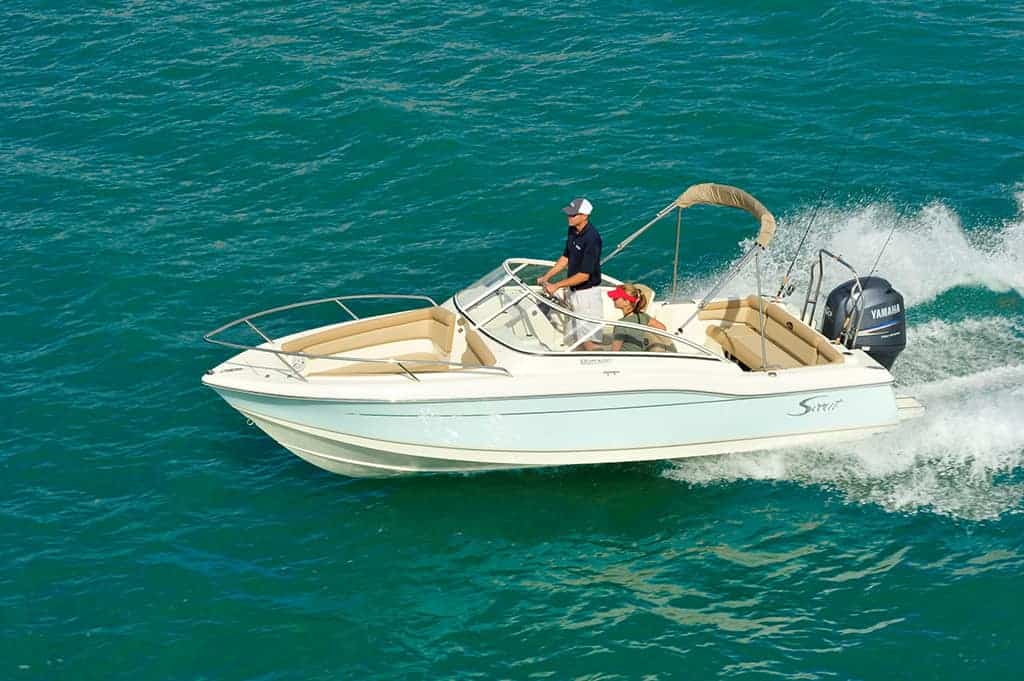
If you are thinking of purchasing a yacht, you may have also been told that buying a tender boat is a smart choice. But what exactly is a tender boat? And do you need one alongside your larger craft? Learn everything you need to know below!
If you’d like to purchase a new tender boat, design one to fit your exact needs with our Build Your Scout tool. You can add features for fishing, sporting, entertainment, and more to best enjoy your boating experience!
Tender Boat Defined
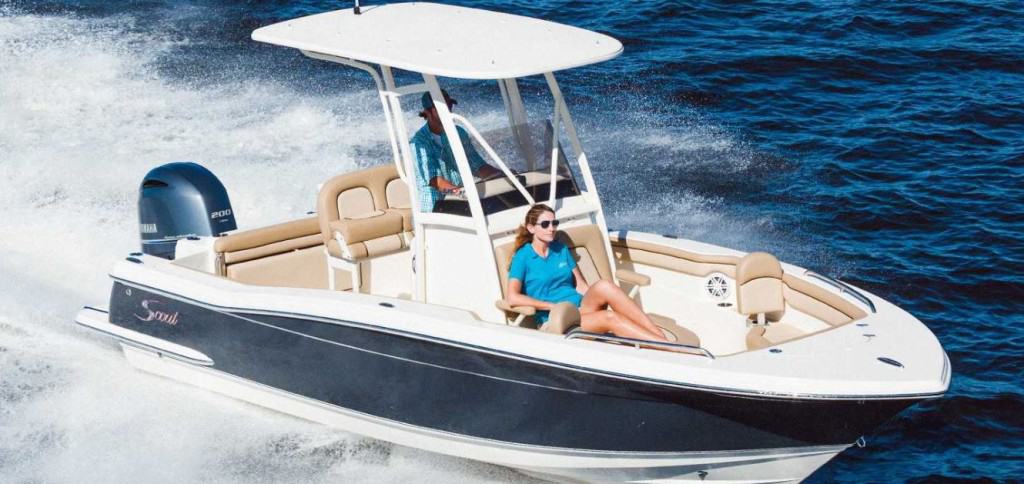
A tender boat—also simply called a tender—is essentially a smaller craft that runs back and forth from a larger yacht or ship. Tender boats address the needs of the larger craft, performing tasks that the bigger boat cannot. They can be used for a variety of purposes, including fetching supplies and equipment, transporting passengers, or simply providing a casual ride on the water. They can, in some cases, also serve as life boats during an emergency. In essence, they navigate the shallow waters that large boats are unable to traverse.
Tender boats often match the luxury and quality of the yacht itself. They are usually loaded with convenience and comfort features, and may even have sleeping cabins and space for numerous passengers.
A tender can be stored on the ship—in fact, they are usually hoisted onto the deck for safe and secure storage. They can also be towed behind the yacht, which provides quick and convenient access to the water.
A Sturdy Tow Eye is a Sign of Quality
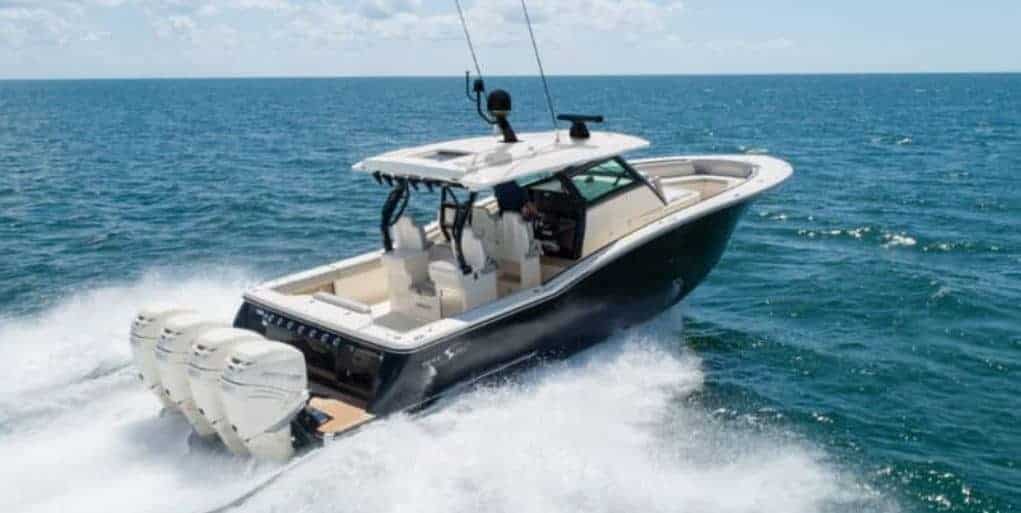
Vessels from Scout Boats are extremely useful as tender boats due to their tough and sturdy tow eye. This tow eye is an indicator of just how popular our boats are among yacht owners and captains.
Located at the front of the boat on the helm, the tow eye allows the craft to be pulled by a larger vessel, such as a yacht. About 50% of our LFX 420 boats, for example, are used as tenders for large yachts, which is why we install these tough and rugged tow eyes.
Scout Boats has an industry reputation as one of the best brands for yacht tenders, and we are extremely proud that our boats are used by yacht owners who have such high expectations for quality and luxury. Our crafts, when used as yacht tenders, are towed all over the world and used in some of the roughest conditions possible. Yacht captains trust Scout Boats to deliver the reliability and performance they expect. With luxury features, refined amenities, and comfort from front to back, our boats are ideal for anyone who owns a yacht and wants to maintain comfort and quality in a tender.
Create a Refined Boat to Match Your Yacht
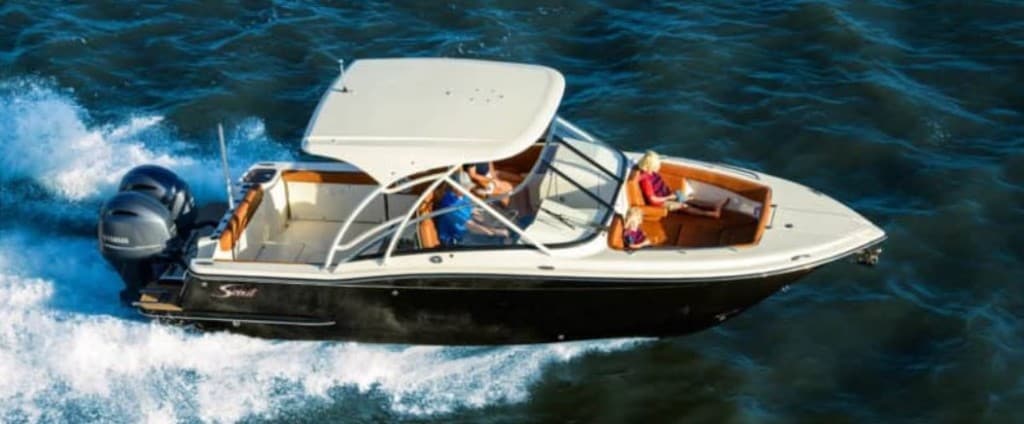
We hope you better understand what a tender boat is! The 420 LXF and 380 LXF make excellent tender boats, but any craft in the Scout Boats lineup will deliver the quality you deserve. Visit one of our excellent dealers to learn more about using a Scout as a tender for your luxury yacht. Or, begin designing the perfect tender for your needs with our Build Your Scout tool now!

Build Your Scout
Click below to build your dream Scout model.

The global authority in superyachting
- NEWSLETTERS
- Yachts Home
- The Superyacht Directory
- Yacht Reports
- Brokerage News
- The largest yachts in the world
- The Register
- Yacht Advice
- Yacht Design
- 12m to 24m yachts
- Monaco Yacht Show
- Builder Directory
- Designer Directory
- Interior Design Directory
- Naval Architect Directory
- Yachts for sale home
- Motor yachts
- Sailing yachts
- Explorer yachts
- Classic yachts
- Sale Broker Directory
- Charter Home
- Yachts for Charter
- Charter Destinations
- Charter Broker Directory
- Destinations Home
- Mediterranean
- South Pacific
- Rest of the World
- Boat Life Home
- Owners' Experiences
- Interiors Suppliers
- Owners' Club
- Captains' Club
- BOAT Showcase
- Boat Presents
- Events Home
- World Superyacht Awards
- Superyacht Design Festival
- Design and Innovation Awards
- Young Designer of the Year Award
- Artistry and Craft Awards
- Explorer Yachts Summit
- Ocean Talks
- The Ocean Awards
- BOAT Connect
- Between the bays
- Golf Invitational
- Boat Pro Home
- Pricing Plan
- Superyacht Insight
- Product Features
- Premium Content
- Testimonials
- Global Order Book
- Tenders & Equipment

6 of the best new tender launches
Related articles.
Fill your garage with the finest and fastest new superyacht tenders and dayboats to hit the water. Sam Fortescue selects the best boats designed to supplement your superyacht...
Compass Tenders
12-13m landing craft.
Compass has embraced the beamy potential of the cat with its latest tender. Hull No 1 was delivered in 2020, featuring a draught of just 57 centimetres and a bow ramp to make beach landings a breeze. With removable seating taken out, the 12-square-metre loading bay packs on water toys and dive kit, complete with removable racks for cylinders. With the seating in, this space can carry eight guests, bringing the total seated passengers to 12. Whatever the configuration, there’s a shaded dining area plus a shower, head and galley. The model is customisable, with Yanmar, Volvo or Cummins engine packages, and Hamilton or Rolls-Royce water jets for a top speed of 40 knots. compasstenders.com
Dario Messina penned the sharp lines and tight styling of the 7.35-metre NY24. It comes in three variants: GT, Deluxe and Limo, with the latter the best contender for superyacht tender use. With a 300hp Volvo D4 putting power into the water via an Aquamatic drive with duoprop, its top speed of 32 knots is guaranteed to ruffle its passengers’ hair. The Deluxe version features stylish pilot chairs by ideaeITALIA, and there’s even room for a convertible sofa berth and heads below. Audiovisual, fridges and almost any other add-on you desire can be fitted, and there’s also a nod to sustainability in the form of Oltremateria, a recyclable finishing material. nereayacht.com
Yachtwerft Meyer
Solaris tender.
Bremen-based Yachtwerft Meyer is well known for its reliable semi-custom support boats, but it was the catamaran tender to 139.7-metre Solaris which caught the eye when it launched in 2021. Engineers employed the same rounded Marc Newson styling as on the mothership, with a frameless curved windscreen, lots of hidden storage, a drop-down beach landing platform and a hydraulic hardtop fixed in just two places. Its twin Hamilton jets are powered by two 480hp Volvo Penta D6s. yachtwerft-meyer.com
Chris-Craft
Launch 25gt.
Also available as an 8.5-metre model, the 7.6-metre 25GT can be specced with sterndrives and a sleek fold-down hardtop for stowing in a large tender garage – its height can be reduced to a little over 1.5 metres at the touch of a button. Options abound, from a heads compartment to trim tabs for wakeboarding. There’s also a forward cockpit, bathing ladder, deck shower and a fine blend of tech and design throughout. chriscraft.com
Falcon Tenders
Miss wonderly.
Southampton-based startup Falcon is carving out a niche for itself in fully custom superyacht tenders, and this 10.6-metre limo is its impressive calling card. Miss Wonderly showcases hybrid drive technology – a cutting-edge engineering feat for boats of this size. This allows the tender to operate in silent electric mode up to about nine knots before the twin 270hp inboards kick in. Elegant furniture below gives Miss Wonderly ’s luxurious cabin a lounge feel, and she is capable of ferrying 14 guests from superyacht to shore. falcon-tenders.com
Beiderbeck Designs
3-in-1 luxury tender.
Smart design thinking from beiderbeck has made it possible to combine a limo, SOLAS and rescue boat into one vessel, winning the Germany-based company a BOAT International Design and Innovation award in the process. Two 11-metre limo tenders are currently in build at Knierim Yachtbau, and a larger 13-metre version for 50 passengers is on the drawing board too. There’s a wetroom and a bar on board, plus comfortable seating throughout. Twin Volvo D4-300 engines give it a top speed of 30 knots. beiderbeckdesigns.de
Onda Tender
Onda Tender’s 371GT flagship model debuted at 2021’s Monaco Yacht Show , following requests for a larger version of the yard’s 331GT model . A generous beam of 3.28 metres coupled with high bulwarks means the vessel can serve as either a day cruiser or a chase tender. The 11 metre Gran Turismo is powered by Yanmar and Mercury Volvo engines for a top speed of 58 knots.
More stories
Most popular, from our partners, sponsored listings.

Navigating Tender Storage: A Comprehensive Guide for Yacht Owners
When it comes to yachting, a well-chosen and properly stored tender is a key component that enhances both convenience and versatility during your maritime adventures. Selecting the right storage location for your yacht's tender is crucial, as it affects the overall functionality and aesthetics of your vessel. In this article, we'll explore various tender storage options based on different yacht styles, outlining the pros and cons of each approach, along with guidelines for securing your tender effectively.

Yacht Tenders: A Precious Companion
Yacht tenders are essentially smaller boats that serve as shuttles between your yacht and the shore, offering transportation, water sports opportunities, and additional storage. Their versatile nature makes them invaluable assets for yacht owners, so finding the ideal storage solution is paramount. Depending on the yacht and tender type there are different options for stowing.
1. Fishing Boats: Utilizing the Bow or Swim Platform
For fishing-oriented yachts, the choice of tender storage depends on the layout and priorities of the vessel. Placing the tender on the bow using a davit allows for quick launching and retrieval, making it convenient for fishing trips without obstructing the main deck. On the other hand, positioning the tender on the swim platform provides easy access to the water for fishing and watersports activities.

Quick access to fishing grounds.
Preserves the main deck space for angling activities.
Separates tender activities from the main vessel.
Potential obstruction of views and aesthetics.
Limited space for larger tenders.
Requires careful maneuvering during tender deployment.
2. Flybridge Yachts: Garage, Swim Platform, or Flybridge Aft
Flybridge yachts offer multiple storage options for tenders, each catering to specific preferences and requirements. Tenders can be stored in a garage beneath the aft deck, providing a clean and clutter-free look. Alternatively, placing the tender on the swim platform offers easy access to the water and additional deck space. Some flybridge yachts even have aft-mounted cranes to carry the tender on the flybridge itself.
Garage storage maintains a sleek exterior appearance.
Swim platform placement encourages water activities.
Flybridge storage maximizes available space.
Garage space may limit the size of the tender.
Swim platform storage might obstruct access to the water.
Flybridge storage could impact the vessel's stability and aesthetics.

3. Sport Yachts: Garage or Swim Platform
Sport yachts often feature a blend of performance and luxury, necessitating efficient use of space. Storing the tender in a dedicated garage or on the swim platform allows for flexibility in design and usage.
Garage storage maintains a clean profile.
Swim platform placement encourages water interaction.
Limited garage space for larger tenders.
Swim platform storage could impact water access.

Securing Your Tender: Best Practices
Irrespective of the chosen storage location, ensuring the safety and security of your tender is of utmost importance. Here are some general guidelines:
Properly Secure: Utilize strong and reliable tie-downs, straps, and chocks to prevent movement during transit or rough seas.
Weather Protection: Use covers or enclosures to shield the tender from the elements, prolonging its lifespan.
Maintenance Routine: Regularly inspect and maintain the tender to prevent damage and deterioration.
Weight Distribution: Consider the yacht's balance and stability when positioning the tender.
Communication: Establish clear communication protocols between crew members responsible for tender handling.
Selecting the appropriate storage location for your yacht tender is a crucial decision that directly impacts your yachting experience. The choice should be influenced by your yacht's style, intended activities, and space constraints. By carefully weighing the pros and cons of various options and adhering to best practices for securing your tender, you'll ensure that this essential vessel serves you well on every voyage.

About Argos Nautic: A Premier Tender Manufacturer
When it comes to premium yacht tenders, Argos Nautic stands as a top-tier manufacturer renowned for its innovative designs and superior craftsmanship. With a commitment to delivering excellence, Argos Nautic offers a range of meticulously crafted tenders that complement the luxurious lifestyle of yacht owners.
Argos Nautic's portfolio includes tenders designed to seamlessly integrate with various storage configurations on yachts of different styles. Their dedication to quality and functionality ensures that yacht owners can confidently select a tender that suits their needs, whether it's stored on the bow, swim platform, or within a garage.
To explore Argos Nautic's exquisite range of yacht tenders and find the perfect match for your vessel's storage requirements, visit Argos Nautic's Official Website . Elevate your yachting experience with a tender that reflects the epitome of luxury and performance.
Disclaimer: The information provided in this article is based on general principles and recommendations. Yacht owners should consult their vessel's manufacturer and professionals for specific guidance tailored to their yacht and tender setup.

Exploring the World of Luxury Lake Boats

Miami International Boat Show 2022

Sumptuous 10-Foot RIB Render

Fort Lauderdale International Boat Show November 1-5, 2017
RECENT POSTS

Unveiling Elegance: Argos Nautic Shines at the 2023 Fort Lauderdale Boat Show

Unleashing Summer Fun: Exploring the World of Yachting Adventures with Yacht Tenders and Yacht Toys

Choosing Your Yacht Tender Engines: Outboard vs. Jet vs. Diesel Engines

Yachts 101: Types of Yachts & Yacht Tenders

New article in Southern Boating Magazine

Step-by-Step Guide to Checking for Leaks in Inflatable Rib Tender Tubes

How to choose a tender for your Yacht

COMPACT JET TENDER ALWAYS MAKES AN ENTRANCE
SEARCH BY TAG

+1 (305) 449-9215
Yachting Monthly
- Digital edition

How to use a tender safely
Chris Beeson
- January 17, 2017
Are you kitted out for tender travel? Chris Beeson reminds you what you need and why

Bring a few essentials on every tender trip and you’ll be ready for anything Credit: Colin Work

Trips in the tender are usually brief and uneventful, but some are longer.
If you decide to pack a lunch and explore upriver, you may want extra kit, like the grapnel anchor and short chain and warp we see in the bow of the tender above, but most are short ferry trips.
That being the case, it’s easy to become blasé about them but if, for whatever reason, something goes wrong, you’ll need a Plan B.
This is just a quick reminder about what you need to do to ensure you arrive safely.
Fit a long painter

A long painter leaves space for others
Dinghy docks can get very busy.
A long painter allows you to tie up your tender and let it drift out so others can do the same.
It’s also handy, as seen above, for securing the tender’s bow and stern, which makes it safer to board or disembark via the transom.
Check your tube pressure

An in-line pressure gauge costs less than £20
Pump up the tender to the correct pressure, as recommended by the manufacturer.
Few tenders are sold with a pressure gauge included but you can buy one in the chandler’s.
Don’t forget to take the pump with you too, just in case.
Dip the fuel tank

Check your fuel level before you leave
You’ve spent too long shopping, the ebb’s started and you’ve got to get half a mile upriver.
You fire up the outboard, zip off and the engine dies, leaving you with an energy-sapping row back to the boat.
Check the tank and it could save you a back-breaking hour.
Use an outboard lanyard

A lanyard could save your outboard
When transferring the outboard from boat to tender, and vice versa, the person not holding the engine grabs the lanyard.
That way, if someone drops the outboard, you can stop it sinking.
When it’s on the tender’s transom, tie the end to a strongpoint onboard.
Tighten the clamps

Spin them up tight to make sure it stays put
Once the outboard’s in position, twirl up the clamps tight.
Check them now and then during the trip to make sure the engine’s vibration hasn’t loosened them.
Outboard theft isn’t uncommon, so, if you’re leaving her for a while, padlock the clamps together.
Bring the oars

You can row your way out of most scrapes
Whether it’s the mercurial nature of outboards, or just a peaceful evening in an anchorage that you don’t want to spoil, a good pair of oars is essential.
If you can’t row a fair distance with the ones that came with your tender, buy a decent pair.
Rig the killcord

It takes seconds to fit. Don’t forget it
No-one needs reminding why this is absolutely essential.
This wriggly bit of plastic with a clip at either end is an unlikely looking lifesaver, but that’s exactly what it is.
Don’t go anywhere without it.
Stow it away from UV when not in use, it will last longer.
Bring spare fuel

Bring spare fuel and secure the can
You’ll be glad of it if you’ve got a long chug ahead.
It’s also easier to take the humble jerrycan to the petrol station.
Tie it to the thwart with a bit of gash line so it won’t bounce out if you hit a wave, and fill the tank in gulps. Don’t pour fuel or it could overflow.
Wear a lifejacket

It’s a simple enough rule, don’t break it
If you’ve never tried scrambling from the water into an inflatable tender, worse still a rigid tender, you should give it a go.
See how you get on.
Perhaps then you won’t need convincing to wear a lifejacket for every tender trip, no matter how short.
Continues below…

We Tested 16 of the Best Lifejackets for Boating and Sailing
We all have lifejackets on board, but do you know what yours is actually like to use? We test 10…

Best portable sailing dinghies for under £5k
We put six inflatable sailing dinghies under £5,000 to the test to see which one is the best all-rounder and…

Grim statistics for non-lifejacket wearers

What’s the safest way to get from tender to yacht?
The simple transfer of kit and crew has resulted in people in the water, and lives being lost. Chris Beeson…
Take a torch

Head torch or hand, it’s a must-have at night
As well as allowing you to do at night all the things you do during the day, from checking your footing to rigging the killcord or finding your elusive yacht in an anchorage, a torch also acts as an emergency nav light, which means you can see and be seen, too.
Bring a handheld VHF radio

Always have some means of two-way comms
Maybe you’ve fallen overboard, maybe you’re lost and need talking in, maybe you’re in a shop standing before a bewildering array of baked goods with ‘bread’ on your shopping list?
Whatever the reason, a VHF, or a mobile phone in a waterproof case, will get you heard.

Check your elbow room

Your crew won’t thank you for a black eye
I can’t be the only one who’s yanked the pullcord and knocked someone clean off the tube and into the drink.
Not a popular move.
Have a quick glance behind and make sure you’ve room to swing the cat.
Don’t wear your backpack

Fall in and it’s Davey Jones’s locker for you
What happens if you encounter a steep wake and end up in the oggin?
The backpack will float at first, pushing your head under, then it’ll flood and take you down.
Buy a waterproof one and put it on the sole.
Don’t overload the tender

It’s tempting, but don’t. Make a second trip
Labouring across an anchorage with an inch of freeboard is likely to end both damply and unhappily.
Make two trips: safer, simpler, probably quicker too.
With a rigid tender that can be swamped, it’s properly dangerous.
What is a Tender on a Boat: A Comprehensive Guide
by Emma Sullivan | Jul 26, 2023 | Sailing Adventures
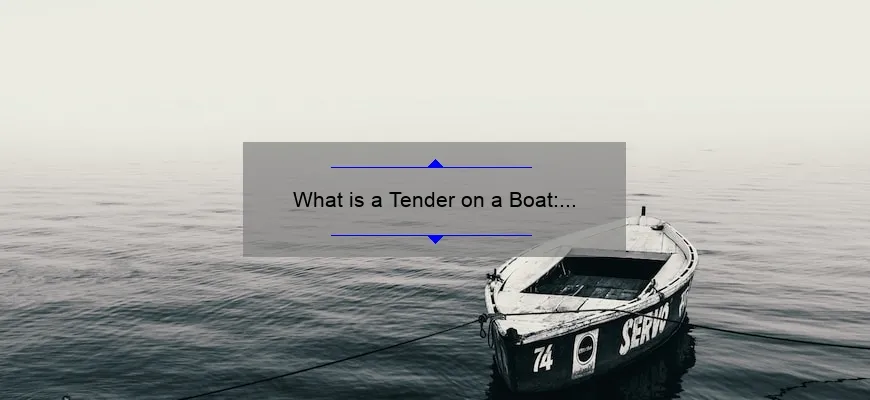
Short answer: What is a tender on a boat?
A tender refers to a smaller boat or vessel that is used to transport people, supplies, or even equipment between a larger vessel (such as a yacht or ship) and the shore. These boats are typically lightweight, easy to handle, and often equipped with an outboard engine for propulsion. They play a crucial role in providing transportation and access to areas that the main vessel may not be able to reach directly.
Understanding the Basics: What is a Tender on a Boat?
When it comes to boating, one term you might often hear is “tender.” But what exactly does this term refer to? Don’t fret! In this blog post, we will unravel the mystery behind what a tender is and delve into its significance in the world of boating.
At its core, a tender refers to a smaller vessel that accompanies a larger boat or yacht. Think of it as a trusty sidekick, always ready to assist its bigger counterpart. This secondary vessel serves numerous purposes and proves essential for various boating adventures.
One of the primary functions of a tender is transportation. As most boats are too large to dock in shallow waters or narrow harbors, tenders come into play by ferrying passengers, supplies, and even leisure equipment between the primary vessel and land. They act as loyal comrades, ensuring seamless travel and accessibility in areas where the main boat cannot venture.
But wait – there’s more! Tenders also serve as valuable exploration tools for their owners. Whether you’re longing to explore hidden coves or reach pockets of untouched beaches, these nimble vessels excel at navigating through tight spaces and shallow depths where larger boats dare not tread.
Furthermore, tenders offer an unparalleled level of flexibility when it comes to adventuring in remote locations. With their compact size and maneuverability, they allow boaters to anchor further from shore while still having convenient access to all those picturesque spots that beckon your inner explorer.
In addition to their utilitarian aspects, tenders have become quite popular amongst boat enthusiasts due to their multifaceted nature. Many luxury yachts now opt for high-end tenders that serve as auxiliary entertainment spaces. These lavish additions are equipped with luxurious seating areas, wet bars stocked with refreshing beverages, and even state-of-the-art audiovisual systems – making them excellent spots for lounging in style or hosting sunset soirees.
Now that we have established what a tender is and the purposes it serves, let’s delve into some fascinating trivia! Did you know that tenders come in various forms – from inflatable dinghies to rigid-hulled vessels? This diversity reflects the diverse needs and preferences of boaters worldwide. So whether you’re sailing alongside a sleek motor yacht or a classic sailing vessel, there’s undoubtedly a tender out there to suit your specific requirements.
So, next time you find yourself aboard a boat or planning an excursion on the water, remember the vital role played by tenders. With their ability to transport, explore, and even entertain, these trusty sidekicks truly enrich the boating experience.
In conclusion, understanding what a tender is unlocks endless possibilities for adventure at sea. From practical transportation to thrilling exploration and even opulent entertainment spaces, tenders truly embody the spirit of versatility on the water. So hop aboard your main vessel, secure your belongings in the tender’s compartments, and get ready for unforgettable experiences only made possible by these invaluable companions of modern boating.
Exploring the Functionality of a Tender on a Boat
Title: Exploring the Functionality of a Tender on a Boat: Beyond Just an Auxiliary Craft
Introduction:
When it comes to recreational boating, owning a tender is more than just an optional accessory; it is an essential tool that offers incredible functionality and enhances the overall boating experience. This blog aims to delve into the various aspects of tender usage and explore why it goes beyond being a mere auxiliary craft. So grab your life jacket and embark on this journey with us as we uncover the wonders of owning a tender.
1. Versatility at its Best:
A tender is not just another type of small boat; it’s a versatile vessel that serves multiple purposes on the water. From transportation between shore and larger boats to providing access to shallow or secluded areas, tenders prove their worth in various ways. For those who enjoy exploring hidden coves or fishing in hard-to-reach spots, having a reliable tender can present endless opportunities.
2. Safety First:
One cannot overstate the importance of safety while out at sea, and in this regard, tenders play a critical role. In emergency situations, tenders act as crucial backup vessels, offering an immediate means of evacuation or rescue if required. Additionally, they serve as efficient support ships when participating in water sports activities such as wakeboarding or skiing.
3. Convenience Personified:
Imagine being able to freely go ashore whenever you desire without relying on marina services or public docking facilities—this is where tenders truly shine. They allow boaters to easily visit nearby restaurants, attractions, or even remote islands without worrying about moorage availability or logistics issues.
4. Enhanced Exploration Opportunities:
Tenders enable boaters to venture further into uncharted waters—both literally and metaphorically speaking! From discovering hidden beaches only accessible by small crafts to exploring remote channels and narrow riverways, owning a tender opens doors to new adventures previously unfathomable.
5. Practical Transportation:
Ever arrived at your destination only to be confronted with limited docking options? Fear not, as a tender allows you to anchor offshore while conveniently ferrying passengers and supplies back and forth between the boat and the shore. These capabilities make a tender an integral part of fishing trips or beach outings, where carrying equipment, food, and people becomes a breeze.
6. Entertainment Center:
Far from being just a functional vessel, tenders can also serve as centers for entertainment while on board the main vessel. Outfitted with comfortable seating, waterproof speakers, and even practical storage solutions for drinks and snacks, tenders set the stage for socializing and enjoying water-based activities away from the main boat.
7. Capturing Memories:
Imagine gliding along turquoise waters in your tender, capturing stunning sunset shots or wildlife encounters that may have gone unnoticed from the larger boat’s deck. Tenders offer photographers and nature enthusiasts unparalleled opportunities to get up close and personal with their subjects in ways that larger crafts simply cannot replicate.
Conclusion:
In conclusion, owning a tender is more than just possessing an auxiliary craft; it opens new horizons of functionality, convenience, safety, exploration opportunities, and memorable experiences on the water. Whether it’s practical transportation between your boat and shore or unlocking hidden gems in remote locations – tenders truly transform boating adventures into something extraordinary! So next time you see a tender floating alongside a magnificent yacht—remember that behind its unassuming appearance lies immense potential waiting to be unleashed!
Step-by-Step Guide: How to Use a Tender on a Boat
Ahoy, fellow sailors! Today, we embark on an exciting journey into the wonderful world of using a tender on a boat. Whether you’re an experienced mariner or a curious landlubber looking to explore the open waters, this step-by-step guide will equip you with the knowledge and skills to make the most of your tender experience. So, grab your life jacket and let’s set sail!
Step 1: Prepare for Launch Before even contemplating launching your tender, it’s essential to ensure that all safety precautions are in place. This means having life jackets readily available for all passengers, having necessary communication devices onboard such as radios or cell phones, and checking weather conditions for any potential hazards.
Step 2: Familiarize Yourself with the Tender Every tender is unique in its design and operations. Take some time to study its features – become acquainted with its controls, seating capacity, and any particular guidelines provided by the manufacturer. Knowing what makes your tender tick will go a long way in ensuring smooth sailing.
Step 3: Securely Attach the Tender Now comes the thrilling part – attaching the tender securely to your boat! Most boats have specific attachment points designed for this purpose. Make sure you use sturdy ropes or straps suitable for marine use – double-checking their strength and condition before proceeding.
Step 4: Lower the Tender into Water Gently lower your tender into the water using either davits (a mechanical device) or manually ladders if it’s a smaller type of boat. Take care not to damage either vessel during this process while maintaining balance at all times.
Step 5: Boarding Time! With your trusty tender now floating gracefully alongside your boat, it’s time to hop aboard! Distribute weight evenly across both vessels as you transition from one platform to another – ensuring safety and stability throughout this transfer.
Step 6: Start the Engine Just like any other mode of transportation, a tender requires sufficient power to set sail. Check the fuel levels, prime the engine if necessary, and follow your tender’s specific instructions to give it the starting kick it deserves.
Step 7: Navigate with Confidence Now that you’re all set up and ready to explore, remember to proceed with caution and navigate responsibly. Familiarize yourself with local marine regulations, maintain appropriate speeds in congested areas, respect wildlife habitats, and always keep an eye out for potential dangers or obstacles.
Step 8: Anchoring Etiquette Sometimes, you may want to pause your adventure momentarily and anchor off in serene surroundings. Brush up on proper anchoring techniques – avoiding sensitive coral reefs and maintaining a safe distance from other boats. As responsible seafarers, we leave only a temporary footprint behind.
Step 9: Returning Home All good things must come to an end; eventually, it will be time to head back. Similarly as when boarding initially: ensure everyone is seated safely before undocking from your secret escape cove. Remember to secure any loose items on deck during the journey home – wind can be mischievous!
Step 10: Rinse & Repeat (Optional) If you’ve caught the boating bug after this incredible experience (we wouldn’t blame you!), rinse and repeat these steps whenever you wish to venture out into uncharted waters again.
And there you have it – a comprehensive step-by-step guide on how to use a tender on a boat! By following these instructions diligently while adding your touch of witty charm along the way, your tender experiences are bound to become delightful adventures filled with memories that make waves. Fair winds and happy sailing!
Frequently Asked Questions about Tenders on Boats
Tenders are an essential aspect of boating, offering a convenient and practical means to access shorelines or explore areas unreachable by the main vessel. However, they can also present some uncertainties and confusion for boat owners. To shed light on this topic, we have compiled a list of frequently asked questions (FAQs) about tenders on boats to provide you with detailed and informative answers.
1. What is a tender?
A tender refers to a smaller boat or vessel that is used to transport people or goods between the shore and the main boat, commonly referred to as the “mother ship.” It acts as an auxiliary mode of transportation, enabling boaters to access remote locations that might be impractical or impossible for larger vessels.
2. Why should I invest in a tender for my boat?
Investing in a tender offers numerous benefits. It expands your exploration capabilities by allowing you to reach shallow waters, secluded coves, or narrow channels inaccessible by larger vessels. Tenders also come in handy for various activities such as fishing, water sports, ferrying guests ashore, or simply taking leisurely trips around anchorages.
3. What types of tenders are available?
Several types of tenders cater to different preferences and needs. Rigid Inflatable Boats (RIBs) combine durability with stability and excellent maneuverability, making them popular choices among boaters. Alternatively, one may opt for traditional hard-bottomed inflatables or lightweight dinghies based on their specific requirements.
4. How do I choose the right size of tender for my boat?
Selecting the appropriate size depends on factors such as your vessel’s size and its carrying capacity limitations outlined by the manufacturer. Consider both length and weight restrictions imposed by your boat before purchasing a tender – balancing functionality with compatibility is crucial.
5. How should I store my tender when not in use?
Storing your tender efficiently ensures its longevity and preserves valuable space on your boat. Davits, which are specialized cranes or hoists, often offer a convenient solution by allowing the tender to be suspended from the mother ship’s stern. Alternatively, you can use dedicated storage compartments on board, inflate/deflate as needed, or choose foldable tenders that occupy minimal space.
6. Do I need any special equipment for launching and retrieving my tender?
Launching and retrieving your tender safely requires some essential equipment. A sturdy set of dinghy wheels or an easily attachable-outboard engine is beneficial while ashore. Additionally, investing in a reliable lifting harness or davit system for effortless launching and hauling can prove invaluable.
7. Are there any legal requirements for using a tender?
Legal requirements regarding tenders may vary based on your location. It’s crucial to familiarize yourself with local laws governing small watercraft operations, including licensing, capacity limitations, navigation lights, personal flotation devices (PFDs), and even permits if necessary. Making safety compliance a priority ensures both peace of mind and adherence to regulations.
8. How should I maintain my tender?
Regular maintenance guarantees optimal performance and longevity for your tender. Rinse it with fresh water after each use to prevent saltwater corrosion, check the engine regularly if equipped, and deflate/fold it correctly when storing or transporting long distances.
Navigating the world of tenders on boats can seem daunting at first, but armed with these FAQs and their detailed answers; you’ll be well-equipped to make informed decisions regarding the purchase, usage, storage, and maintenance of a suitable vessel tailored to complement your boating experiences effectively.
The Essential Role of Tenders in Boating: A Detailed Overview
Title: The Essential Role of Tenders in Boating: A Detailed Overview
Introduction: When it comes to boating, there’s more to the experience than just the main vessel. Tenders, also known as dinghies or small boats, play a vital role in enhancing and expanding the possibilities of boating. In this detailed overview, we will explore the essential role that tenders fulfill, highlighting their importance and utilities for both recreational and professional boaters.
1. Versatile Transportation Solution: Tenders offer a versatile transportation solution for boaters. Whether you need to shuttle guests from shore to your yacht or explore shallow waters where large vessels cannot venture, tenders serve as reliable transport options. Their compact size enables easy maneuverability through tight spaces and difficult terrains.
2. Safety Measures and Emergency Preparedness: Tenders act as an essential safety measure on larger vessels by providing an emergency escape option in case of unforeseen events such as fire or other emergencies. They become crucial lifelines during distress situations, ensuring everyone’s safety by facilitating quick evacuation when needed.
3. Exploration and Leisure Activities: Tenders enable boaters to access marinas, docks, secluded beaches, or hidden coves that may be inaccessible by larger boats due to depth limitations or crowded areas. They create opportunities for leisure activities like fishing expeditions, snorkeling adventures, water sports enjoyment (e.g., water skiing or tubing), and wildlife spotting in hard-to-reach locations – all contributing to unforgettable boating experiences.
4. Efficient Provisioning Support: For extended trips or cruising adventures, tenders prove invaluable in acquiring provisions at nearby ports or grocery stores without moving the primary vessel from its mooring location. This flexibility ensures seamless provisioning logistics while saving time and fuel costs associated with navigating large boats into harbors for supplies.
5. Tender as a Workhorse: Beyond recreational purposes, tenders often double up as workhorses for boat owners, captains, and crew members. They are instrumental in carrying out various tasks such as transporting heavy equipment, performing maintenance and repairs on larger vessels, and providing a versatile platform for deploying diving or surveying equipment.
6. Diverse Applications in Professional Boating: In professional boating sectors like sailing charters, yacht racing support teams, or scientific research expeditions, tenders become indispensable. From transferring personnel to coordinating logistics or ensuring quick response during races, these small-sized boats efficiently fulfill numerous specialized requirements across the maritime industry.
Conclusion: Tenders play a multifaceted role in boating that cannot be overlooked. Whether you’re a recreational boater seeking adventurous exploration or a professional enthusiast undertaking complex projects on the water – tenders deliver enhanced mobility, safety measures, leisure opportunities, logistical support, and so much more. Recognizing their essential role opens up endless possibilities for optimizing your boating journey while reaping the countless benefits they offer both practically and recreationally.
Unveiling the Various Types of Tenders Found on Boats
Unveiling the Various Types of Tenders Found on Boats: A Comprehensive Guide
When it comes to exploring the vast waters, boats are the undisputed kings of the sea. However, even these majestic vessels require smaller companions called tenders to accompany them on their adventures. Tenders play a vital role in enhancing the overall experience, making them indispensable for any boating enthusiast.
But did you know that not all tenders are created equal? In fact, there is a plethora of tender types available today, each serving different purposes and catering to specific boating needs. Join us as we embark on an exciting journey to unveil the various types of tenders found on boats – from traditional dinghies to cutting-edge amphibious craft!
1. Dinghies: Let’s start with the classic choice – dinghies! These compact and lightweight tenders are typically made from materials like inflatable PVC or aluminum. Their primary purpose is transportation, whether it’s ferrying passengers and supplies between shore and boat or assisting in docking maneuvers. With their easy maneuverability and efficient storage capabilities, dinghies have stood the test of time as a reliable companion for boaters worldwide.
2. RIBs (Rigid Inflatable Boats): When you need more stability and durability than what a regular dinghy can offer, RIBs come into play. Known for their sleek design and tough construction, RIBs feature rigid hulls with inflatable collars around them. This combination ensures excellent buoyancy while providing increased safety in rough waters. RIBs prove incredibly versatile, excelling in tasks such as water sports activities or even emergency rescue operations.
3. Jet Tenders: For those seeking speed and agility on the water, jet tenders are the ultimate thrill ride! Powered by jet propulsion systems instead of traditional outboard engines, these compact vessels can reach impressive speeds while maintaining exceptional maneuverability. Through clever engineering, jet tenders eliminate the need for a propeller, making them ideal for cruising in shallow waters or exploring hidden coves without any worries of damaging marine life.
4. Crew Boats: As the name suggests, crew boats are designed with functionality and utility in mind. These robust tenders prioritize transporting crew members, supplies, and equipment to and from larger vessels efficiently. Equipped with ample seating and storage space, crew boats ensure smooth operations on board by facilitating seamless cargo transfers or serving as a reliable platform for maintenance tasks.
5. Amphibious Tenders: Imagine seamlessly transitioning between land and water without any hassle – that’s precisely what amphibious tenders bring to the table! These cutting-edge marvels combine the capabilities of small boats and off-road vehicles in one extraordinary package. Thanks to innovative technologies like retractable wheels, amphibious tenders can smoothly navigate various terrains before effortlessly launching into water with the press of a button. With unrivaled versatility, they are perfect for adventurers who crave exploration beyond traditional boating limits.
So there you have it – an extensive overview of the diverse types of tenders found on boats! Whether you’re looking for practicality, speed, or versatility, rest assured that there’s a tender out there perfectly suited to your needs.
Now that you’re armed with this knowledge, go forth and embark on your boating adventures with confidence – knowing that your trusty tender will always be by your side!
Recent Posts

- Sailboat Gear and Equipment
- Sailboat Lifestyle
- Sailboat Maintenance
- Sailboat Racing
- Sailboat Tips and Tricks
- Sailboat Types
- Sailing Adventures
- Sailing Destinations
- Sailing Safety
- Sailing Techniques
RIBs – 31ft

Center Consoles – 30ft

Cabins / Bow Riders – 30ft

Customization

- Amphibious Uses
- Waterfront Properties
- Private Islands
- Yacht Tenders
- Hotels & Resorts
YACHT TENDERS
The ultimate yacht tenders for guests.

Use Anytime to go Anywhere
The Iguana yacht tenders can conquer any terrain. Land on the beach and disembark effortlessly from a steady platform without getting your feet wet.

Live Comfortable and Safe Experiences
Amphibious yacht tenders are safer. Protect guests from the swell and boat wash when you disembark on beaches.
Enjoy a Multipurpose Yacht Tender
Use your Iguana yacht tender for all types of activities like cruising, fishing, water-sports. The Iguana is built as a boat first.
Escape the Ordinary with our Yachts Tenders
Unlimited access to shores enables guest to experience limitless freedom. This unique luxury yacht tender provides new adventures and endless exploration.
SUPERYACHTS ENJOYING AN IGUANA TENDER
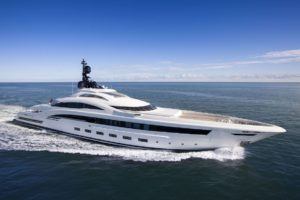
Lenght: 73 m / 239'
Builder: crn, tender type: iguana original.
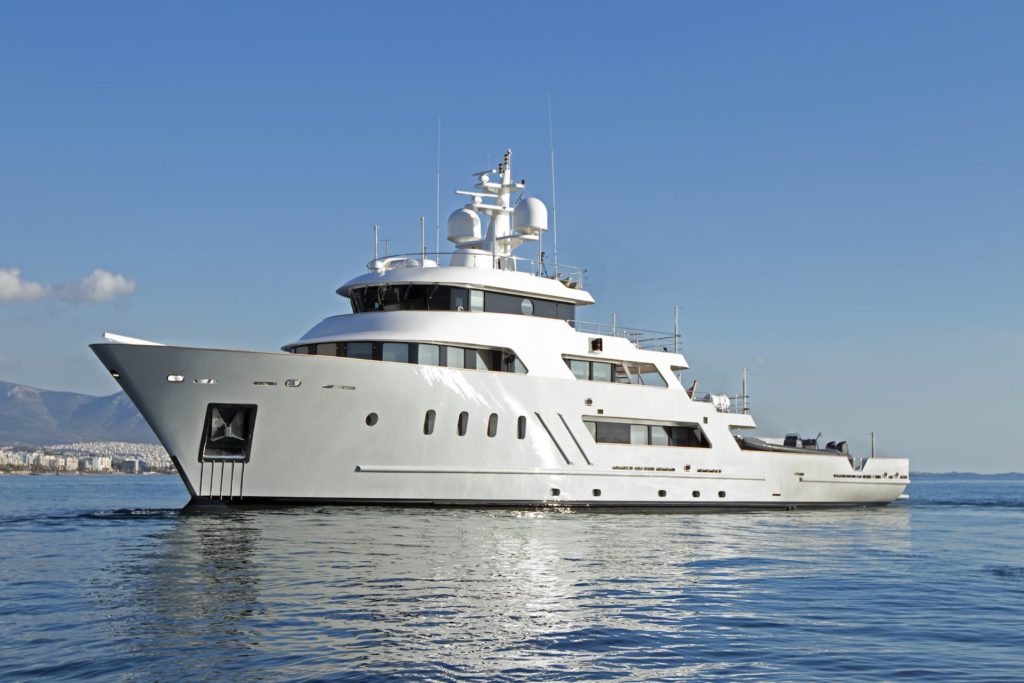
M/Y MASQUENADA
Lenght: 51 m /167', builder: penglai, tender type: iguana knight.
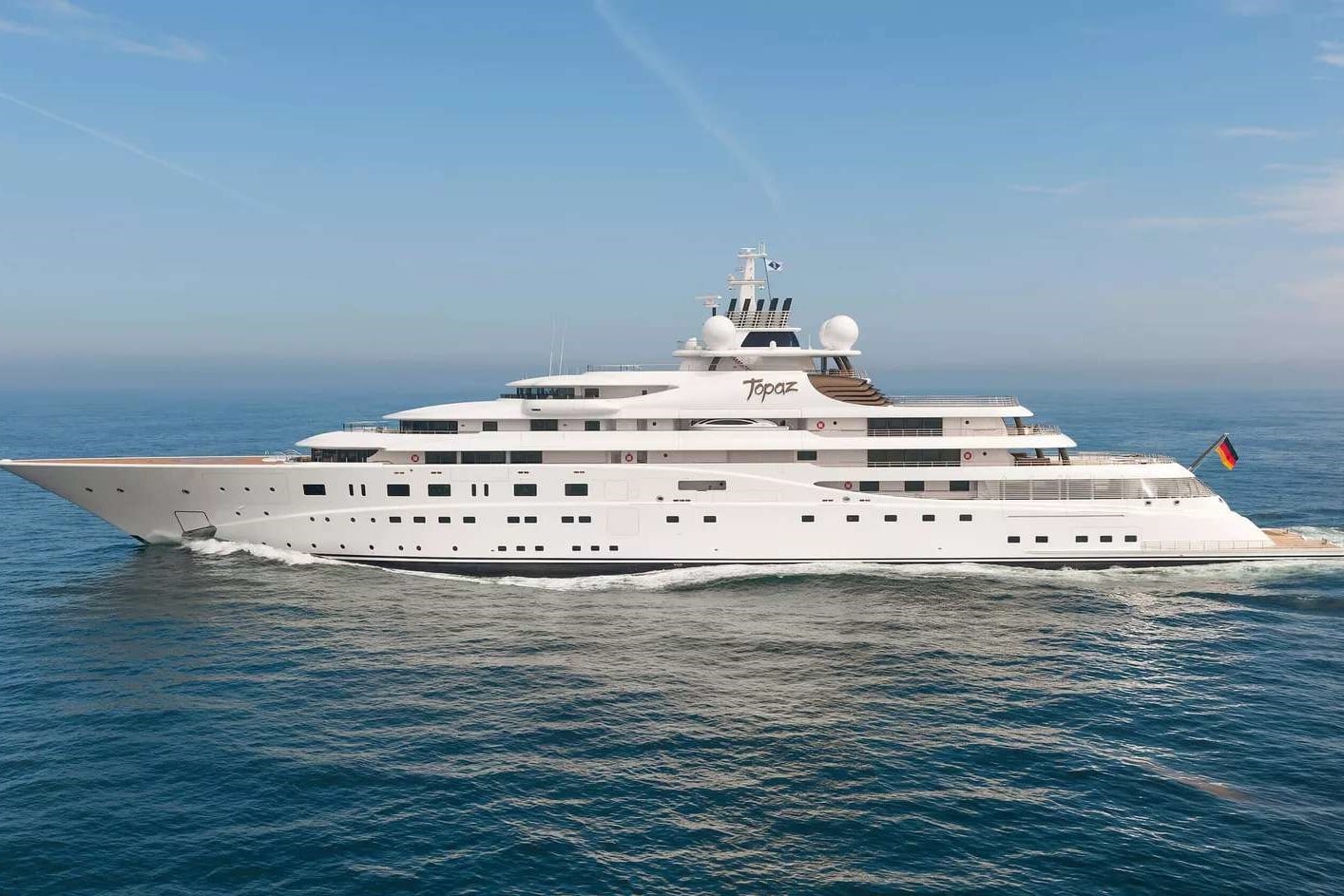
Lenght: 147 m / 482'
Builder: lurssen.
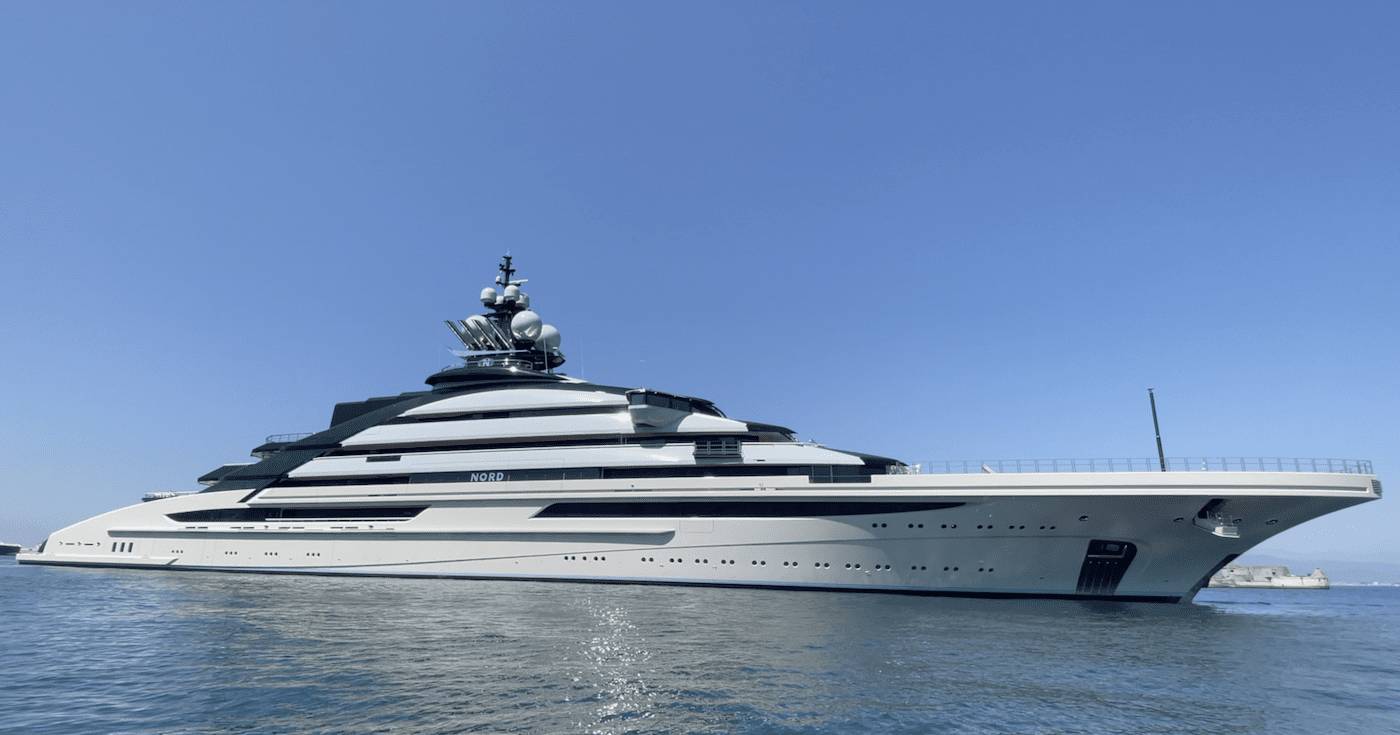
Lenght: 142 m / 465'
Tender type: iguana commuter.
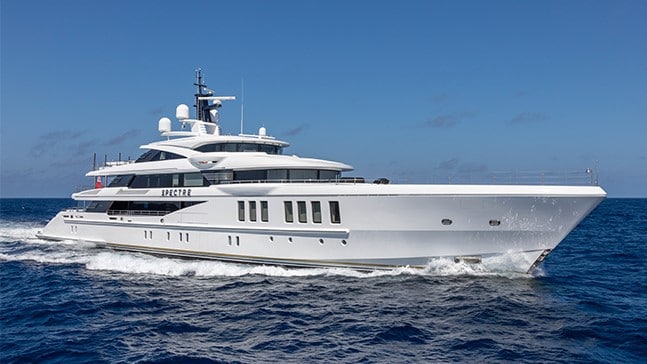
M/Y SPECTRE
Lenght: 69 m / 226', builder: benetti.
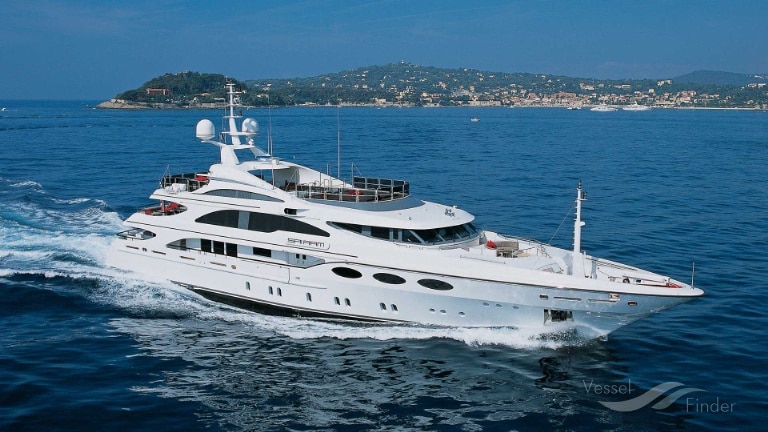
Lenght: 52 m /170'
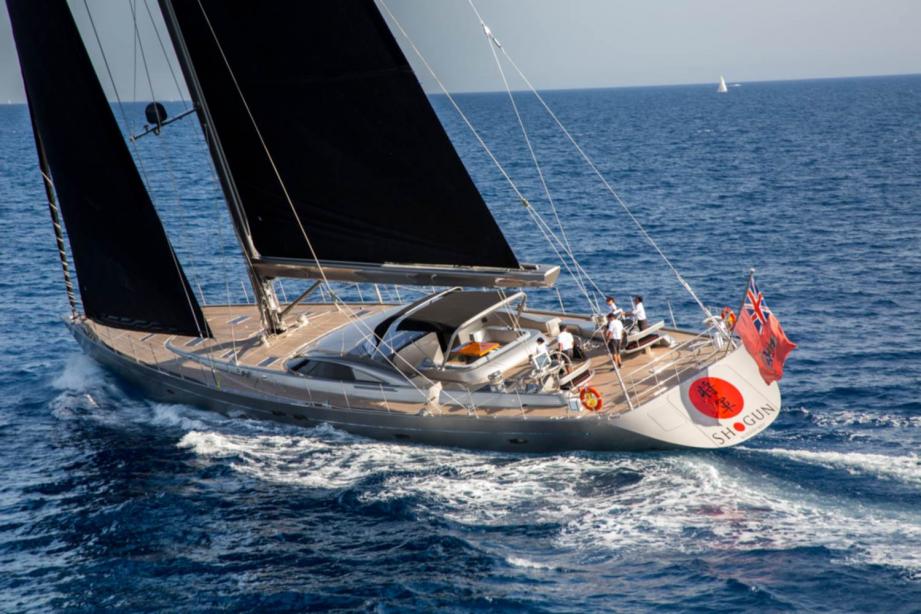
Lenght: 37 m / 121'
Builder: holland jachtbouw.
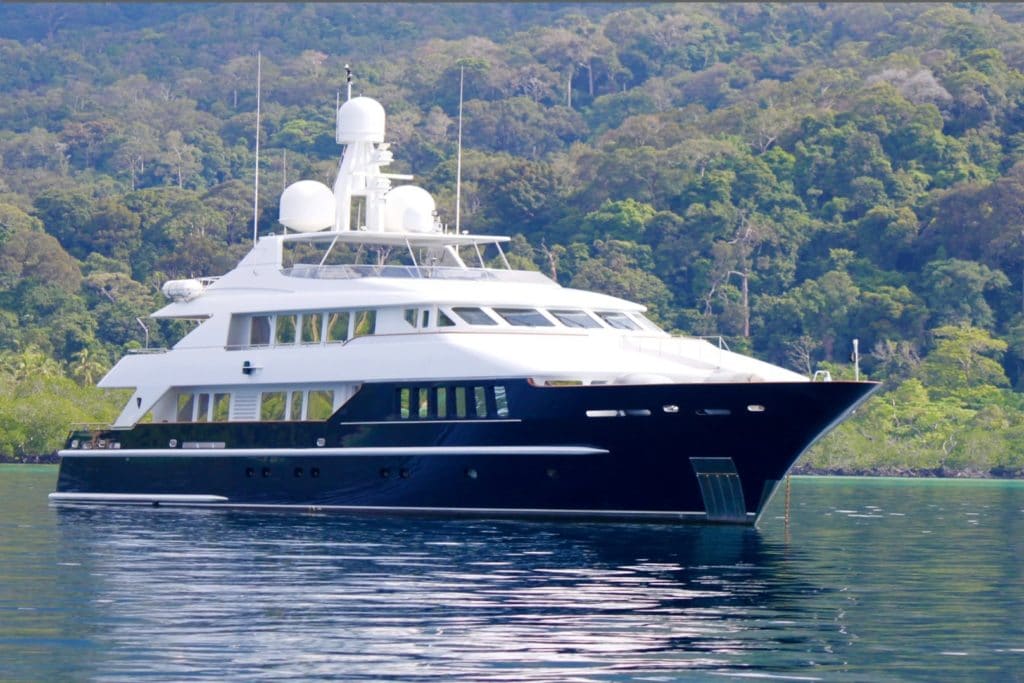
M/Y LADY AZUL
Lenght: 39 m / 128', builder: heesen.
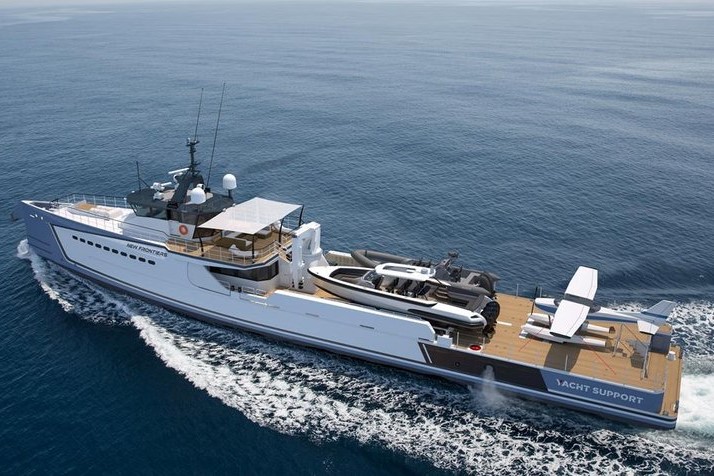
Lenght: 55 m /180'
Builder: damen yachting, tender type: iguana x100.
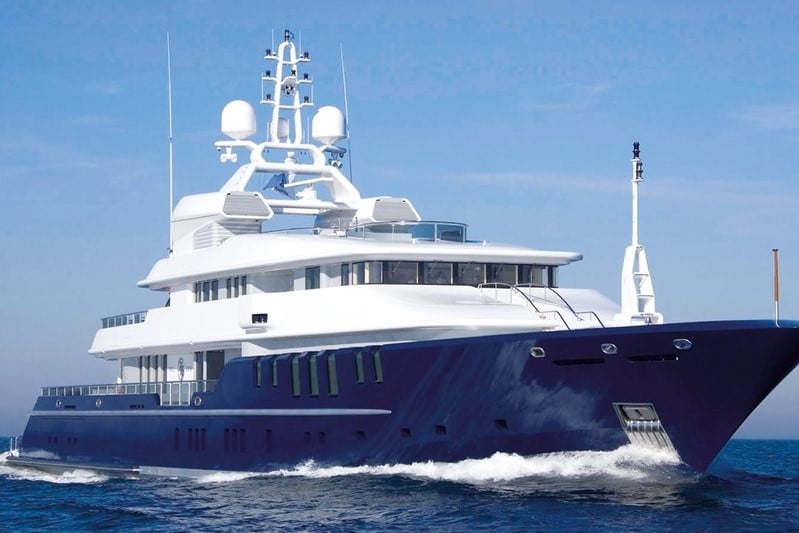
Lenght: 68 m / 223'
Builder: nobiskrug, project examples.
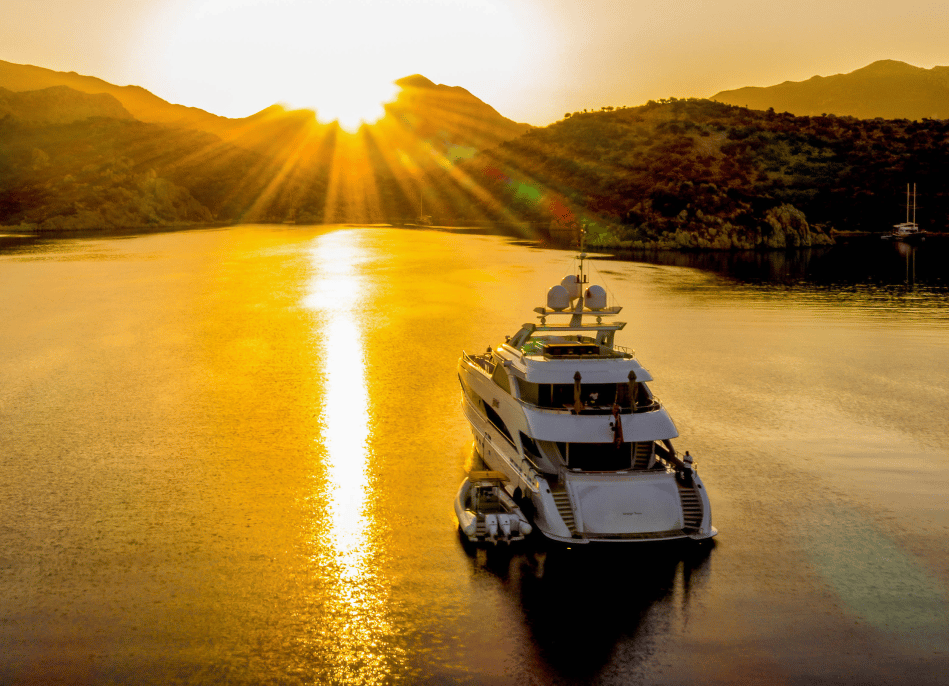
M/Y JEMS - CHASE BOAT TENDER
Iguana x100 white edition.
This 44m yacht enjoys an Iguana X100 White Edition as a tender to explore the Mediterranean seas. Used as a chase boat, the Iguana is also easily towed.
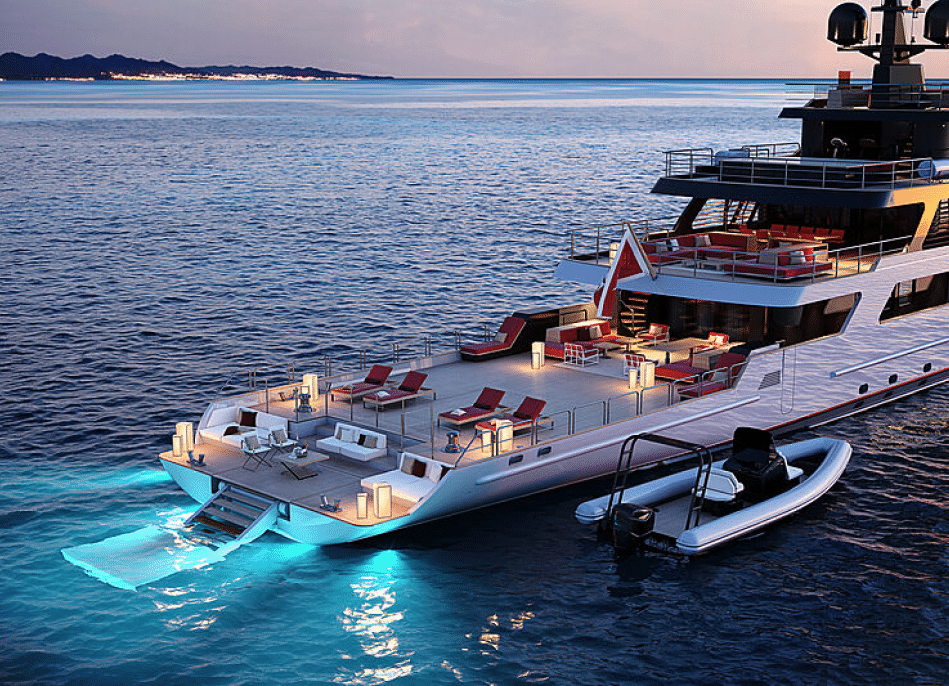
M/Y MASQUENADA - EXPLORER YACHT
Iguana knight - bespoke.
This 51m refitted explorer yacht has a custom RIB Iguana tender onboard the mothership. Equipped with a diesel outboard, the “Iguana Jones” is perfect for exploring and going on adventures.

CUSTOM TENDER PROJECT FOR BIKERS
This superyacht owner built a very unique bespoke tender for his yacht, this Iguana can embark motorbikes onboard to use on remote islands and beaches.
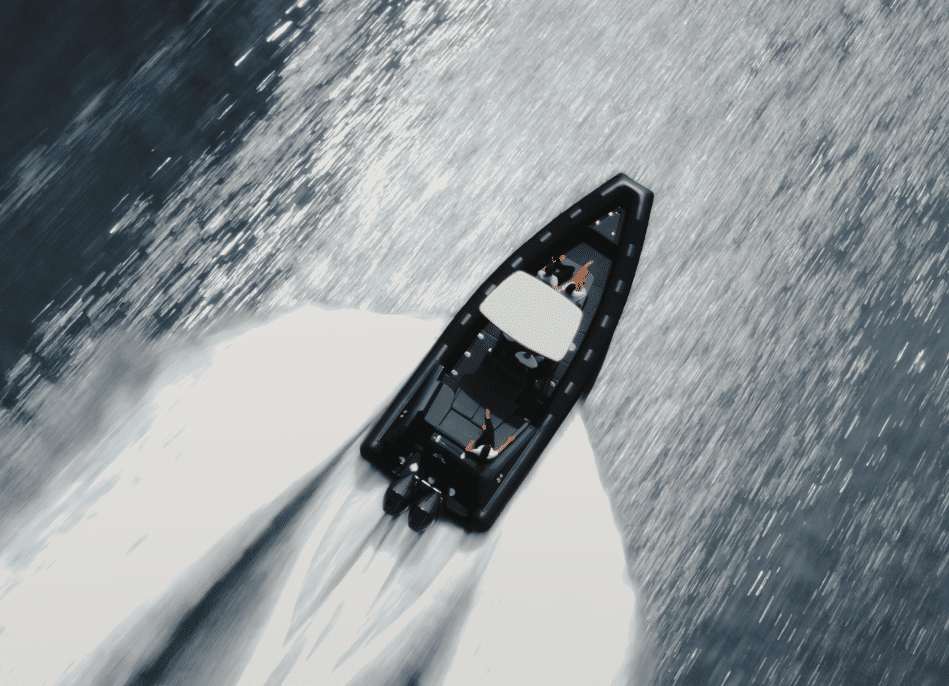
CUSTOM TENDER PROJECT FOR SPEED
Iguana pro rider - bespoke.
Highly inspired by professional Iguana Pro models, the Iguana Pro Rider is powerful and fast. It is used as a tender to go from the house to the yacht.
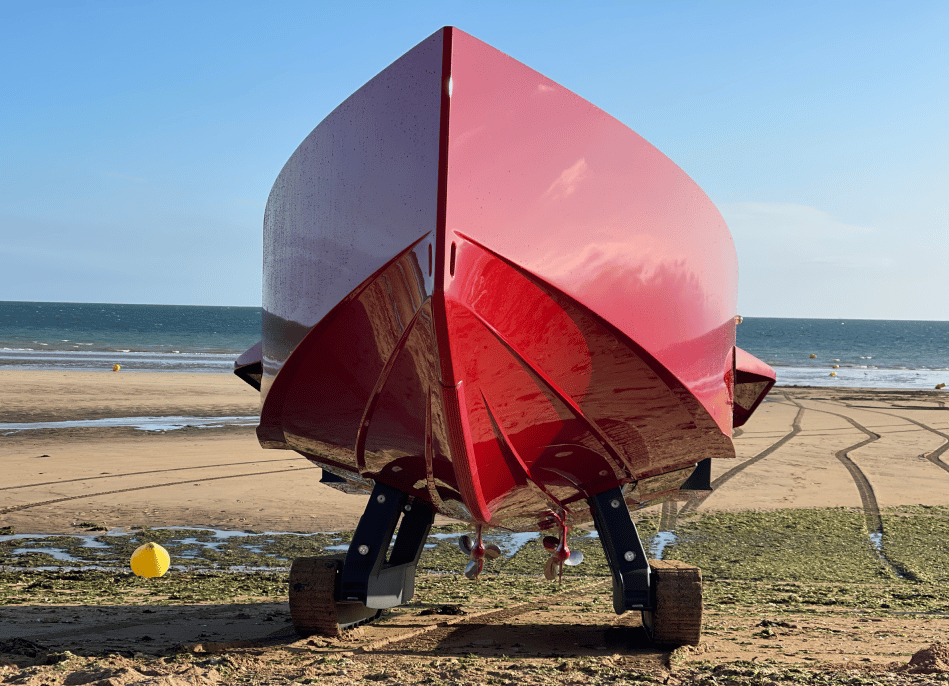
STYLISH IGUANA ORIGINAL TENDER
Iguana original.
This yacht opted for an Iguana Original to transport guests with style and comfort. Painted in red, this tender is beautiful and unique. The tender is stored inside the yacht garage.
MAKING YACHT CREWS WORK EASIER

Very Reliable and Robust Yacht Tenders
No compromise has been made on toughness, overall weight, or agility. With a reinforced carbon structure, kevlar reinforcement on tracks, and marine-grade aluminum for the mobility system, the Iguana yacht tenders are very reliable.

Transport Guests in Style and Safely
Pick up your guests, from any beach without needing a dock. the Iguana mobility system enables seamless beach landings. But Iguana yachts tenders also provide unrivaled capability with a dry, safe, and stable ride at sea.

Easy to Maintain and Store
With only minor preventive maintenance, the Iguana Mobility System delivers long-term, hassle-free operation. Sleek lines and customized boats ensure that the Iguana can be fitted into your yacht garages.

Simpler Beach Set-ups
Reduce the amount of crews needed to set up picnic areas as the boat can be parked on land no one is needed to hold the boat or help unload. Also, the Iguana offers many features from showers to sound systems and heads that can be used on the beach.
Exploring Greece with the Iguana chase boat tender
The beautiful iguana x100 white edition.
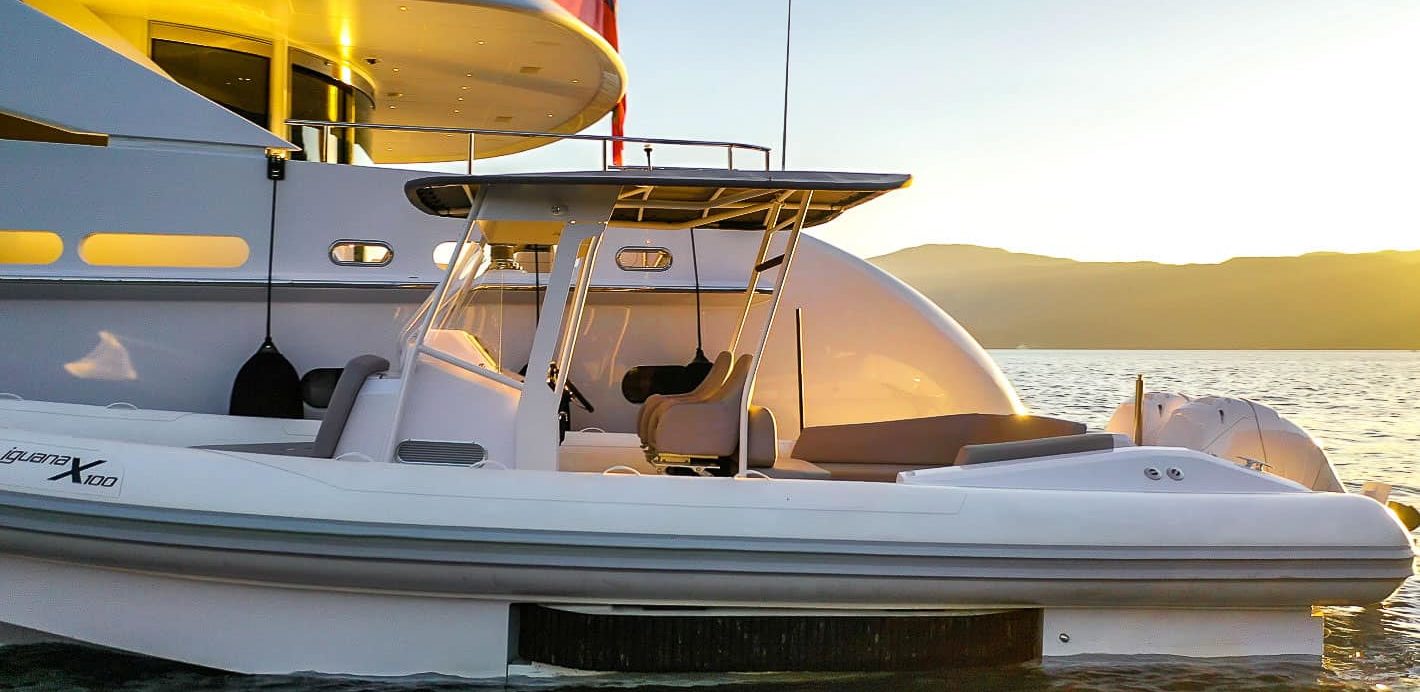
AMPHIBIOUS YACHT TENDERS BENEFITS
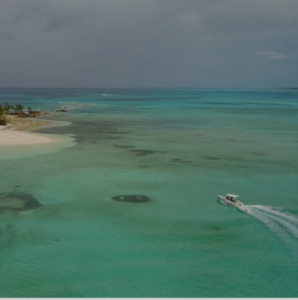
IGUANA KNIGHT
A beautiful RIB tender combining elegance and performance with premium features as standard.
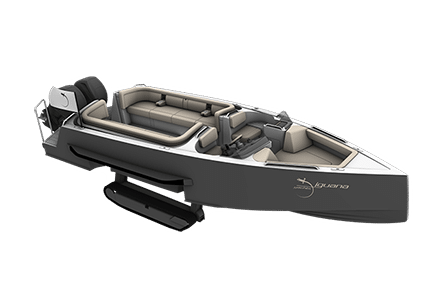
IGUANA DAY LIMO
The Iguana Day Limo is the ideal tender to transport guests comfortably to isolated beaches
IGUANA TECHNOLOGY
Discover the unique Iguana Mobility System and its unbelievable capabilities.
PREMIUM SERVICE
Enjoy your boat every time with peace of mind with the Premium Service Pack.
Learn more about the Iguana models to find the best features for you.
- Aftersale Services
- Brochures & Prices
- Hotels & Resorts
- Governments
- Iguana X100
- Iguana Fisher
- Iguana Sport
- Iguana Knight
- Iguana Bow Rider
- Iguana Commuter
- Iguana Original
- Iguana Day Limo
- Iguana Foiler
- Bespoke Projects
- Pre-owned Iguanas
©2020 Iguana yachts - Legal Notice - Privacy Policy

What Does "Tender" Mean On a Sailboat?

Last Updated by
Jacob Collier
August 30, 2022
When sailing on a large boat, there are times when you need something smaller to navigate certain areas. This is when a sailboat tender comes in handy.
Think about setting your anchor down and exploring shallow waters. What is a tender sailboat and how can it help in this situation?
Tender boats are smaller vessels that allow you to travel from a larger boat to shallow waters. These boats are called “tender” since they tend to the larger boat’s needs. This includes retrieving supplies, navigating areas too shallow for the larger boat, and a life boat for emergencies.
Tender boats will often mirror the quality of the larger boat itself, depending on the preference at the time of purchase. They can even be stored on the ship or towed behind as an added convenience. Some tender boats are night and day in comparison, with some providing the best quality available.
According to coast guard regulations, tender boats have to be treated as regular travel boats or rescue boats. Regardless of the use of these boats, it would not hurt to properly have everything you need in the event of an emergency.
Table of contents
History of a Tender Boat
Tender boats have roots to almost any small boat traveling on water in history that tended to the needs of larger boats. It was not until the 20th century that these boats were heavily popular and a common tradition was born.
Around the 1870’s, a 13-year-old boy named Chris Smith had just created his first boat and began the production of runabouts. By the 1920’s, a company he started had changed their name to Chris-Craft and they were building mahogany powered yacht tenders with inboard engines.
Around the 1940’s during WWII, they used a different style of large tender boats to offer supplies and support to the submarine vessels. Once the war ended, these particular boats were no longer needed.
Looking at today’s tender boats, you will likely see larger boats having some kind of tender boat but on a much smaller scale compared to WWII. In addition, these boats are being used differently as well.
For example, many tender boats will be available on cruise ships to allow passengers to ride to the dock when the ship cannot pass through. If not on the cruise ship themselves, there are usually tender boats waiting to help out.
Characteristics of a Tender Boat
A tender boat is often a general reference to another small boat called a dinghy. Dinghies will vary in size and shape, usually between six and 24 feet long.
Some tender boats have motors or simply just need oars to operate. In addition, these could be inflatable ones similar to military use or solid hulls that you would find for most options.
There are some rigid inflatable boats on the market that provide stability and efficiency without compromising comfort. These boats have a strong hull with inflatable tubes along both sides.
When looking at tender boats, you want to make sure it has a heavy duty towing eye. This means you should check the quality of the tow eye on the front of the boat.
If you plan on towing your tender boat in the water behind your larger boat, you want to make sure it can handle rough conditions. The strength of your tow eye and quality of the tender boat you have chosen need to have a great correlation in safety.
In addition, towing behind greatly accelerated the wear and tear of the tender boat. An inflatable boat, one that you store after each use or a heavy duty one that you keep out, will significantly have less damage over time.
Why Would You Need a Tender Boat?
Tender boats, for a little extra money, allow you to enjoy the entire sailing experience. Depending on certain needs, everyone will have their preferences in why they need a tender boat.
If you want to take your tender boat out for some fast paced action, there are some that reach as high as 46 knots. This is a great opportunity to reach high speeds on the water without using your main vessel that would be beaten up by the waves.
When speaking about tender boats, sailors know that this type of boat serves a variety of purposes. If you plan on making trips often to shore, you might need something a little more rigid and durable to withstand constant use.
In the event of an emergency, you still want a reliable mode of transportation. However, you might not spend the extra money in luxury if you only plan on using your tender boat for emergency situations.
Your first step would be to consider what the tender boat will be to your current situation. This will allow you to narrow down options more efficiently and not rush into a purchase for a tender boat that does not meet your expectations.
Which Tender Boat is Right for Me?
Tender boats are a similar idea to your family car or as another reliable form of transportation. It might not be the main attraction, but it still serves an important purpose.
When considering a tender boat, remember to vision all of the scenarios you plan on taking it through. There are some factors that separate tender boats from one another that should be considered before a purchase.
Size Plays a Role
Depending on the size of your sailboat or yacht, you might have a specific size in mind for your tender boat. For example, if you have a 33 foot sailboat or small yacht and a 20 foot tender boat, the size of that particular tender boat might be overkill for just a few people.
If you are currently in that situation, you obviously have no choice but to tow the tender boat behind you unless it was one that you had to inflate every time. In that case, you could inflate the tender boat only when needed.
The size of the tender boat for larger sailboats might be considerably bigger if you plan on making one trip to the dock and back with a handful of people. Knowing how many people you will typically travel with makes a big difference in tender boat decisions.
Functionality of Tender Boat
These are a few of many questions you should ask yourself before considering a tender boat. How often do you plan on using your tender boat? Do you enjoy navigating areas where your larger boat cannot reach?
Some owners might like to have faster tender boats, while others do not mind slowly cruising around. This will all depend on your tastes as a consumer.
Available Free Space
The amount of space available for where you are going to store your tender boat is typically a great place to start when considering a tender boat. You also need to consider storing the boat onto your large vessel or tow behind you while traveling.
If you plan to store your vessel while traveling, you need to see how much room it will take up. You also need to factor in how heavy the tender boat is in this situation because it could affect the performance of your larger boat.
Money Arguably is Decision Maker
The price of a tender boat will often vary in quality and functionality. If you have a luxurious blue water sailboat, you are likely going to want a tender boat that matches the occasion.
Some tender boats might only cost a few thousand dollars or so, while others are over a million dollars. These are going to vary wildly since it depends on quality, inflated or solid hull, and luxury.
Keep in mind that there are plenty of cheaper options and you do receive what is paid for. If it gets the job done, the price might not matter as much.
Related Articles
Born into a family of sailing enthusiasts, words like “ballast” and “jibing” were often a part of dinner conversations. These days Jacob sails a Hallberg-Rassy 44, having covered almost 6000 NM. While he’s made several voyages, his favorite one is the trip from California to Hawaii as it was his first fully independent voyage.
by this author
Most Recent

What Does "Sailing By The Lee" Mean?
Daniel Wade
October 3, 2023

The Best Sailing Schools And Programs: Reviews & Ratings
September 26, 2023
Important Legal Info
Lifeofsailing.com is a participant in the Amazon Services LLC Associates Program, an affiliate advertising program designed to provide a means for sites to earn advertising fees by advertising and linking to Amazon. This site also participates in other affiliate programs and is compensated for referring traffic and business to these companies.
Similar Posts

How To Choose The Right Sailing Instructor
August 16, 2023

Everything You Can Pull Behind A Boat
May 25, 2023

Cost To Sail Around The World
May 16, 2023
Popular Posts

Best Liveaboard Catamaran Sailboats
December 28, 2023

Can a Novice Sail Around the World?
Elizabeth O'Malley
June 15, 2022

4 Best Electric Outboard Motors

How Long Did It Take The Vikings To Sail To England?

10 Best Sailboat Brands (And Why)
December 20, 2023

7 Best Places To Liveaboard A Sailboat
Get the best sailing content.
Top Rated Posts
Lifeofsailing.com is a participant in the Amazon Services LLC Associates Program, an affiliate advertising program designed to provide a means for sites to earn advertising fees by advertising and linking to Amazon. This site also participates in other affiliate programs and is compensated for referring traffic and business to these companies. (866) 342-SAIL
© 2024 Life of Sailing Email: [email protected] Address: 11816 Inwood Rd #3024 Dallas, TX 75244 Disclaimer Privacy Policy

- Center Consoles
- Dual Consoles
- Motoryachts
- Sport Cruisers
- Tenders & Ribs
- U.S. Atlantic
- Engine Buyers Guide
- Electronics
The Right Way to Stow your Tender
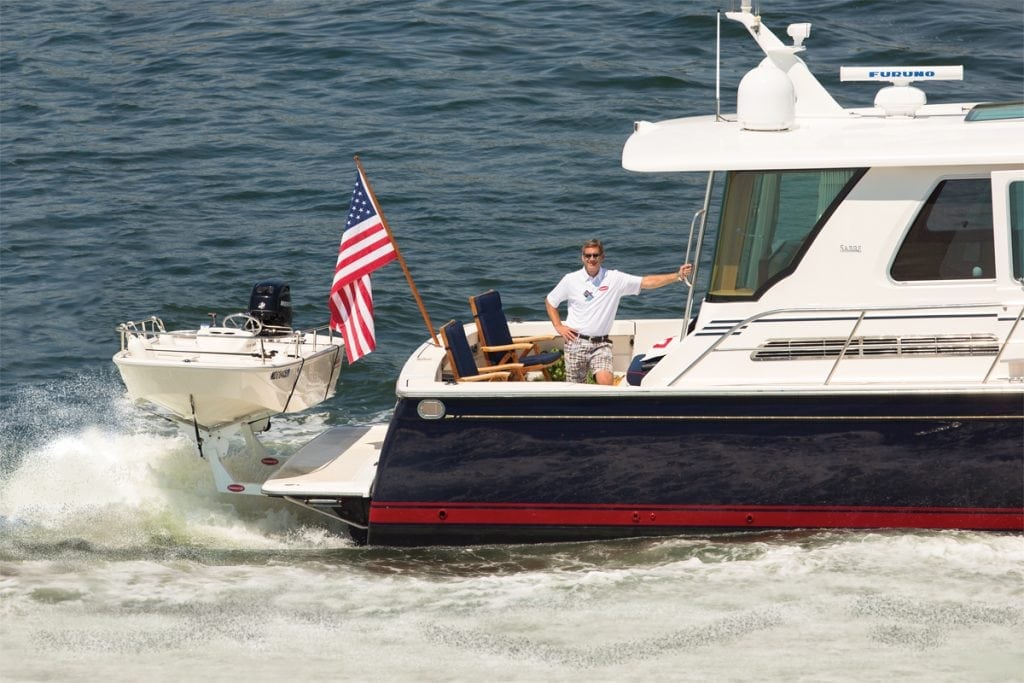
It’s more fun to tour The Bahamas on your tender. Caves, coves, and shallow waters are the perfect tender setting. But how do you stow your tender when playtime is over?

Don’t Stow Your Tender… Tow Your Tender!
Swim platforms.
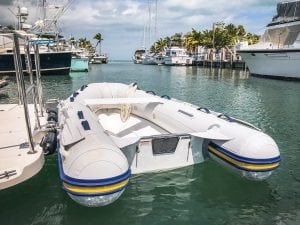
Snap davits
- Privacy Policy

1591 E. Atlantic Blvd, 2nd Floor Pompano Beach, FL 33060 Office: +1 (954) 522-5515 Fax: +1 (954) 522-2260 Contact us: [email protected]
Email address
© 2024 Southern Boating Media
- Motorcycles
- Car of the Month
- Destinations
- Men’s Fashion
- Watch Collector
- Art & Collectibles
- Vacation Homes
- Celebrity Homes
- New Construction
- Home Design
- Electronics
- Fine Dining
- Baja Bay Club
- Costa Palmas
- Fairmont Doha
- Four Seasons Private Residences Dominican Republic at Tropicalia
- Reynolds Lake Oconee
- Scott Dunn Travel
- Wilson Audio
- 672 Wine Club
- Sports & Leisure
- Health & Wellness
- Best of the Best
- The Ultimate Gift Guide
11 Tenders That Might Be Even More Fun Than Your Superyacht
These tenders range from a classic wooden aquarama to limousine models to advanced electric hydro-foilers., julia zaltzman, julia zaltzman's most recent stories.
- This Boatmaker Builds 1960s-Inspired Cruisers With a Modern Twist. Here’s How.
- This 150-Foot Fishing Trawler Was Transformed Into a Rugged Explorer Yacht
- These 3 Miniature Explorer Yachts Are Ready to Take You Off-Grid
- Share This Article

About 60 tenders of all stripes and sizes were on display at last month’s Monaco Yacht Show , from Novamarine’s Black Shiver 160, stretching 56 feet in length (too large for most superyachts to carry on board) to the small 26-foot Lanéva Dayboat, built for performance with a responsive, electric drivetrain.
These days, most superyachts over 120 feet carry at least two tenders on board. Twenty years ago, when the average superyacht size was closer to 80 feet, that would’ve meant a RIB for the crew and a Boston Whaler for guests. Today, it’s not uncommon for gigayachts over 250 feet to have much larger, elaborate limousine tenders with a roof that slides over the cabin, an open sports tender for convenience, and even a Zodiac for heading into remote regions.
The 303-foot Tatoosh , built by Nobiskrug in 2000, was among the first yachts with a deck that carries two 39-foot tenders: a Hinckley motoryacht and a Frers daysailer. It also holds three other tenders, a safety boat and four Sea-Doos. Meanwhile, the 296-foot classic yacht Nero , also on display last month at the Monaco show, brings glamor to any occasion with its custom-built wooden Corsair tender. At the futuristic end, America’s Cup Emirates Team New Zealand last year launched a hydrogen-fuel-celled tender, Chase 0 , to show that emissions-free hydrogen fuel cells could be a viable alternative to fossil fuels.
“Many superyacht owners and project managers are looking to tender manufacturers to bridge the gap between performance and ocean preservation,” Mark Pascoe, founder of Falcon Tenders, told Robb Report, noting the company uses the latest hybrid and electric propulsion in its tenders. Sustainability is indeed a big theme for tender manufacturers, and many new electric runabout builders are out to convince yacht owners that they can offer the same performance and comfort as a conventional tender, but without the emissions.
In the end, however, there are really just two types of tenders: Those designed to fit into a yacht’s garage, or those that serve as shuttles from the owner’s home port to the mothership.
That means styles and sizes are very much up to the owners. Here are 10 of our favorites, from the Tyde electric hydro-foiler to Riva’s iconic mahogany Aquarama.
Hodgdon Limousine

Heading for a shipyard in Northern Europe to be paired with a superyacht, Hodgdon’s new Limousine has accommodations for up 15, with both forward and aft outside seating areas, a wetbar, climate-controlled interior and a T-top that lowers for when the tender is stowed in the yacht’s garage. It also has gyro stabilizers to minimize motion sickness. The Michael Peters’ design looks more like a Downeast express cruiser than a traditional limo. The deep-V hull is fast and designed for stability in rough water, while the twin Volvo D4-320 engines deliver speed when necessary. The Maine shipyard’s dedication to quality is seen throughout the yacht, including the stainless on the exterior and custom upholstery inside. Even the Hodgdon signature flush anchor is custom fabricated.
Compass Limousine for Oceanco ‘H3’

Custom-built for the 344-foot Oceanco H3 (ex-Al Mirqab and listed among the 25 largest yachts in the world) this 36-foot limousine bears subtle styling characteristics taken from the mothership’s exterior design, including the window shape and hard-top detailing. The cabin features custom leather seating, stainless-steel trim, leather paneling, and a geometric teak floor. There is also an integrated AV system, ambient lighting and forward-facing cameras that display the tender’s journey on twin screens. Access to the cabin is through sliding glass doors fore and aft, while an electric sliding-glass roof opens the interior to the outdoors.
Falcon Project KD

Making its world debut in Monaco last month was Project KD from British builder Falcon Tenders . The custom 32-foot limousine tender was commissioned by the owner of a 210-foot Sanlorenzo yacht due to deliver next year. The fully finished exterior has fiber-optic light lines by Fibr8, powered by lasers to evenly emit light over long distances. The interior design remains under wraps until the unveiling next year. But if Falcon’s recent tenders, the Miss Wonderly and Miss Le Blanc, are anything to go by, the quality of build as well as features like the leather upholstery with its intricate hand-stitched seams, will make Project KD a tender worth waiting to see.
Brabus Shadow 300

Available in two models—a Cross-Bow or Cross-Top—the Brabus Shadow 300 is designed with powerboat enthusiasts in mind. Agile and easy to handle, the 25-foot sportster makes a good superyacht tender. The top speed of 50 knots, thanks to a Mercury 300R V8 racing engine, assures swift passage from the yacht to port. It’s also a great boat for watersports since it’s fitted with a pole for water-skiing, inflatable towing and wakeboarding. Not big enough? Its 38-foot Shadow 900 Black Ops Boat certainly provides a larger and very different look.
J-Craft Torpedo ‘BaBeBi’

Turning heads at both Cannes and Monaco this year was J-Craft’s 42-foot Torpedo BaBeBi . The Swedish builder’s first Torpedo with a metallic-colored hull sports a beautiful brass and off-white interior enhanced by diamond stitching. It’s twinned with serious functionality, capable of sailing in open water and certified to withstand 13-foot waves. Taking over 9,000 man-hours to build and fitted with two Volvo Penta IPS 650s, BaBeBi delivers a top speed of 47 knots. Equipped with lithium batteries for a full day on the water with the engines off, it has a 280-nautical mile range, a convertible open cockpit with two sundecks, and sleeps up to four guests for weekend retreats.
Cockwells ‘Titian ‘Tender

The custom 34-foot Titian tender built by U.K.-based Cockwells is equipped with old-school features like specially cast stainless-steel fittings on the exterior and a Corian and copper galley belowdecks. Its advanced electronics include a virtual anchor and touchscreen digital switching system. Powered by a highly maneuverable twin jet drive, the Titian played a starring role in fashion brand Michael Kors’s 2022 advertising campaign called ‘The Thrill of the Chase’, which saw Bella Hadid aboard the tender on London’s River Thames with Alton Mason in hot pursuit. Finished to superyacht quality standards, Titian won the “Pre-1980s” category of the Concours d’Elégance at last year’s Cannes Yachting Festival. Cockwells also has other mutliple designs under its sleeve. It recently showed a 39-foot hydrofoil limousine that can theoretically cruise at 40 knots.
Riva Aquarama

No tender round-up is complete without mentioning the Riva Aquarama —the most famous of all Carlo Riva’s designs. The Italian builder’s iconic luxury wooden runabout saw a limited run of 281 Aquarama Normals and Supers between 1962 and 1972, when Riva still owned the shipyard, and then 277 more, called the Special, were built in the next two decades. The Aquarama’s speed, grace, and craftsmanship make it a much-desired primary boat, not to mention the world’s most stylish tender. Prices for historically correct can range between $400,000 and $800,000, but much will depend on the actual model and number within the series.
Williams DieselJet 565

Williams is one of the perennial names in RIB tenders, with multiple yacht builders designing their garages around specific models. The DieselJet 565 has several advantages over competitors. First, it’s a jet drive so driving is reliable and maneuverability is excellent. Secondly, it runs on diesel, the preferred fuel for many owners who don’t want to carry the more flammable gasoline on the yacht if they don’t have to. Finally, this nine-passenger design should be able to carry owners and guests in one trip, two in a pinch. Williams paid attention to the details that matter, like ergonomic seating, decent storage, grab rails, and even an optional plate on the yacht’s stern that illuminates the name of the mothership.
Lanéva Dayboat

The Lanéva all-electric dayboat is equipped with a lithium polymer battery designed for military operations, while the two axial-flow motors are used in aviation. It has a wood structure, a deck comprised of sustainable flax and volcanic fibers, a cork floor and a 100 percent recyclable leatherette upholstery. Sporting a cobalt-blue hull, the 26-foot boat brings performance to electric tender design.
The Tyde Icon is a wild-looking 43-footer, a wedge-shaped electric boat that foils to 30 knots. It’s definitely not designed to be loaded into a superyacht garage. But it can make a head-turning tender between an owner’s home and the mothership. Designed in collaboration with BMW, the yacht has large windows for vewing the water as well as lounge chairs across the enclosed cabin. A pair of 100 kW electric motors convert the 240 kWh of energy supplied by six batteries from the BMW i3 for a range of more than 50 nautical miles at a cruising speed of 24 knots.
Sacs Rebel 47

The Sacs Rebel 47 is a great example of a large rigid-hulled inflatable that can serve as both a tender and primary day boat for the owner. It has multiple seating areas across the exterior and a generous cabin below-decks for cooking or taking a nap. The boat’s offshore hull is designed to run at speed in rough water, and of course, the inflatable collar adds an element of buoyancy to the design. With two 440 hp Volvo D6 sterndrives, the boat has a top end of 38 knots. But with three Yamaha 425 hp XTO outboards, that jumps to 50 knots.
Read More On:
More marine.

This New 150-Foot Superyacht Can Cruise Through Shallow Waters in Florida and the Bahamas With Ease

Open Space, Eco-Friendly Tech: What a Rising Class of Millennial Superyacht Owners Is Looking For

‘People Don’t Want to Be Inside’: How the Outdoors Became Yachtmakers’ Most Coveted Design Element

This New 220-Foot Custom Superyacht Is Topped With an Epic Jacuzzi

Culinary Masters 2024
MAY 17 - 19 Join us for extraordinary meals from the nation’s brightest culinary minds.
Give the Gift of Luxury
Latest Galleries in Marine

Palm Beach Vitruvius in Photos

The 10 Most-Exciting Yacht Debuts at the Palm Beach International Boat Show
More from our brands, exclusive: pacsun showcases young music artists for 2024 festival campaign, mlb’s highest-paid players 2024: ohtani on top despite $2m salary, indian rapper badshah on new album ‘ek tha raja,’ working with shah rukh khan, arijit singh: ‘i’m like this cousin who starts the party’ (exclusive), talking galleries conference launches second new york edition, this folding treadmill is 20% off for amazon’s big spring sale.
- French | fr
- German | de
- Italian | it
- Spanish | es
- United-States | us
- English | en
- Zodiac Nautic
- Boat tenders
Tenders & Yacht Dinghies
In addition to your main yacht, sailboat or catamaran,, cadet roll up.
Inflatable dinghy with wooden slatted floor
Its floor, in a wooden slat design, can be rolled and stored in seconds.
Inflatable dinghy with inflatable floor
Very simple and above all really compact! Completely flexible, including the floor, it can be folded and stored in less than 2 minutes in a suitable bag!
CADET RIB ALU
RIB dinghy with aluminium hull
A truly solid-hull dinghy (aluminium), which provides the best in stability and safety on board!
Inflatable dinghy with aluminium floor
An aluminium floor, which can be put in place in no time for maximum stability.
NOMAD RIB ALU
New tenders with a double floor, waterproof storage, and top-quality tubes!
CADET RIB ALU DL
Its biggest asset is its locker: Your backpack or today’s picnic will fit in just fine…
The smallest Open
Ideal for a first boat with room for 4 people on board, it is easy to manoeuvre and tow. Ideal for small budgets.
The ideal electric dinghy
Whether used as a dinghy or a funky little boat, this 3.4 is more environmentally friendly than ever and requires no maintenance.
Ideal dinghy or small robust boat
The 3.4 is sure to please: Easy to steer, 3 large storage lockers! A true little racing kart that will delight you and your guests.
YACHTLINE 360
The smallest Yachtline
An ideal size to accommodate 4 people on board, with a maximum power of 40 HP, it can carry its passengers at high speed.
YACHTLINE 400
Well equipped
The Yachtline 400 can carry 5 passengers with its 3 seats and 50 HP.
The smallest Pro
A traditional model, it has always been part of the Zodiac range.
Unbeatable value for money
Ideal model for fishing and cruising with family or friends with its 4 large seats that can accommodate 6 people on board and its large lockers.
YACHTLINE 440
The right compromise
The ideal complement to transport 6 people, with its numerous storage lockers and its 60 HP.
The biggest of the compact Open
A generous power output of up to 80 CV is a big asset, and it is ergonomic and spacious for comfortable and active days out.
YACHTLINE 490
The biggest
At 4.90m and 90 HP, it can be used as a main boat for up to 9 people. It can also tow water-skiers or wakeboarders.
OUR NAVIGATION PROGRAMS
Are you looking for a tender or dinghy model for your yacht, sailboat or catamaran? The choice of boat will depend on your intended use, frequency of trips, sailing areas and your expectations. Choose a comfortable, innovative and powerful boat that you can accessorise according to your taste and needs. You will already have basic equipment: lifting and towing rings, bench, paddles or oars, many handles … for the comfort of the pilot and the passengers. The design of your dinghy will perfectly match your yacht thanks to its elegant aesthetics. Your RIB dinghy guarantees you excellent performance, great sailing comfort and spaciousness for regular use. Its sturdiness ensures greater safety at sea where the weather is particularly unpredictable.
Versatility
Yacht dinghies serve you both as lifeboats or support boats to get the pilot, crew and guests to land or shore, but also as leisure crafts due to their versatility. The size and engine of the tender mean it can be used as a pleasure boat for sea trips with friends or family; from 4 metres upwards for the larger models. So go and explore some beautiful places. The finish and quality of the accessories ensure the longevity of your boat.
Power and agility
In our range, you will find 100% electric tenders like the eOpen, but also ones with hydrojet propulsion, such as the eJet. This modern technology, which uses a turbine to draw in water and propel it quickly to move the boat forward, offers a more fun and agile way to steer. Compared to an outboard boat with a propeller engine, waterjet propulsion offers greater safety, the ability to sail in shallow water and faster acceleration.
Tender models with rigid hulls such as the CADET RIB ALU, the small OPEN, the eOPEN, or the Yachtline provide you with more stability at sea, even in difficult weather conditions. This gives you more space on board for passengers and storage.
ALL CAPABILITIES
- Boats for 4 people and above
- Boats for 6 people and above
- Boats for 10 people and above
- Boats for 14 people and above
- Boats for 20 people and above
- Tenders from 2 to 3 meters
- Boats from 4 to 6 meters
- Boats from 6 to 8 meters
- Boats from 8 meters boats and above
Green Point beach near Yamba littered with debris after abandoned boat runs aground
A remote beach near Yamba on the New South Wales north coast is littered with debris and diesel after a boat ran aground and was smashed to pieces in the surf overnight.
Witnesses said the boat was abandoned by its occupants as they were attempting to cross the Clarence River bar around lunchtime on Monday.
NSW Road and Maritime said the occupants were evacuated from the vessel by a NSW Marine Rescue crew.
Angourie resident Oli Coe said he later saw the vessel adrift about 2 kilometres offshore.
He watched the boat throughout the day and at one point saw another vessel alongside it.
He said someone boarded vessel and put out its anchor.
"As the wind got up through the rest of the afternoon, we watched the boat drifting and dragging on its anchor and eventually it just dragged way too far and ended up on the beach," Mr Coe said.
At one stage Mr Coe and two friends used jetskis to get out to the boat to see if they could do anything to help.
He said he could not understand why it was not salvaged before it ran aground near Green Point.
"There was definitely some damage to the boat but it was in perfectly good condition [before that]," Mr Coe said.
Clean-up concerns
Locals spent Tuesday morning on the beach, dragging piles of debris above the high tide mark in a bid to ensure it is not taken back out to sea with the next high tide on Tuesday evening.
Angourie resident Kim Wood said the usually pristine beach at Green Point looked like a "rubbish dump".
"I'm looking at kilometres of debris," she said.
"There is timber, there is oil cans, jerry cans full of diesel, so much plastic, and everything is soaked in diesel.
"You can still see all debris in the ocean."
Ms Wood said the area was home to a wide range of birdlife including oyster catchers and curlews.
Too dangerous to tow
NSW Maritime said the boat was deemed too dangerous for authorities to board or tow.
Senior boating safety officer Bret Ryan said authorities needed to put safety first.
"Marine Rescue revisited the boat several times on Monday, and eventually the Water Police came from Coffs Harbour," Mr Ryan said.
"They came to the same conclusion that it was too dangerous."
"At that point the vessel was secure and the hope was it would remain in that position but unfortunately that didn't happen."
Mr Ryan said the main hazard on the beach was from any sharp objects that might remain buried in the sand.
ABC North Coast — local news in your inbox
- X (formerly Twitter)
Related Stories
Lone sailor, 70, winched to safety after yacht slams into 65m cliffs at flinders island.
Luxury Kimberley charter boat runs aground off coast ahead of tourist season
- Maritime Accidents and Incidents
- South Grafton

IMAGES
VIDEO
COMMENTS
A yacht tender is your ticket to freedom on the water. Once you drop anchor, it's your ride to the fun and adventure that inspired you to buy a boat in the first place. Just imagine watersports, exploring, scuba diving, snorkeling and, of course, just relaxing in the warm sun!
Tender boats support the needs of the larger craft, aka the "mothership", performing tasks that the bigger boat cannot. Hence the name "tender". For instance, they are often used to ferry passengers back and forth from the yacht. While tenders are functional, they are also often designed to entertain and exhilarate (except for life ...
Rigid Inflatable Boat (RIB) Rigid Inflatable Open Dive Tow or stow. The workhorse tender of any yacht is the Rigid Inflatable Boat (RIB). Robust, versatile, and highly manoeuvrable, RIBs typically offer speed, buoyancy, and good handling on high seas. A foam or inflatable collar provides extra buoyancy in the event of taking on water, while in ...
If your boat's big enough to carry a tender in chocks on the foredeck, or on a boat deck aft of the flying bridge or upper helm, that's the gold standard, in my opinion. But it takes deck space and a powerful hydraulic crane to handle a tender of any size. Some trawlers have a mast and boom that can lift a lightweight inflatable onto the ...
Yacht tenders come in a range of shapes and sizes and are dependent on a variety of factors, from the owners' use of the vessel, to how large the yacht is to what activities guests wish to carry out. Tender boats are often divided into the following categories: RIBs, Limousines, Custom Tenders, Jet Tenders, Electric Tenders, Sport and Fishing ...
Yacht tenders are larger vessels that are designed to match the style and luxury of the main yacht. Yacht tenders are typically powered by diesel engines and can reach speeds of up to 30 knots. These vessels are perfect for transporting guests to and from the main yacht in luxury and comfort.
A: A center console tender is a type of yacht tender with an open deck design and a steering console located in the center of the boat. Q: What is a jet tender? A: A jet tender is a type of yacht tender that is powered by a jet drive system, using water propulsion instead of an outboard or inboard engine.
A tender boat—also simply called a tender—is essentially a smaller craft that runs back and forth from a larger yacht or ship. Tender boats address the needs of the larger craft, performing tasks that the bigger boat cannot. They can be used for a variety of purposes, including fetching supplies and equipment, transporting passengers, or ...
Nerea. NY24 Limo. Dario Messina penned the sharp lines and tight styling of the 7.35-metre NY24. It comes in three variants: GT, Deluxe and Limo, with the latter the best contender for superyacht tender use. With a 300hp Volvo D4 putting power into the water via an Aquamatic drive with duoprop, its top speed of 32 knots is guaranteed to ruffle ...
A yacht tender is a vessel used for servicing and providing support and entertainment to a private or charter yacht. They include utilitarian craft, powered by oar or outboard motor, and high-speed luxury craft, supporting superyachts, powered by inboard engines, some using water-jets. Some superyachts have a support vessel that follows them ...
Weight Distribution: Consider the yacht's balance and stability when positioning the tender. Communication: Establish clear communication protocols between crew members responsible for tender handling. Selecting the appropriate storage location for your yacht tender is a crucial decision that directly impacts your yachting experience.
Tighten the clamps. Spin them up tight to make sure it stays put. Once the outboard's in position, twirl up the clamps tight. Check them now and then during the trip to make sure the engine's vibration hasn't loosened them. Outboard theft isn't uncommon, so, if you're leaving her for a while, padlock the clamps together.
A tender refers to a smaller boat or vessel that is used to transport people or goods between the shore and the main boat, commonly referred to as the "mother ship.". It acts as an auxiliary mode of transportation, enabling boaters to access remote locations that might be impractical or impossible for larger vessels. 2.
But Iguana yachts tenders also provide unrivaled capability with a dry, safe, and stable ride at sea. Easy to Maintain and Store. With only minor preventive maintenance, the Iguana Mobility System delivers long-term, hassle-free operation. Sleek lines and customized boats ensure that the Iguana can be fitted into your yacht garages.
On smaller ships, the tender boat may be simpler and open-air. This is the case when the distances covered from ship to shore are shorter, or when the passengers tend to more adventurous.
Tender boats are smaller vessels that allow you to travel from a larger boat to shallow waters. These boats are called "tender" since they tend to the larger boat's needs. This includes retrieving supplies, navigating areas too shallow for the larger boat, and a life boat for emergencies. Tender boats will often mirror the quality of the ...
Top 15 Tenders and RIBs Here's a look at some of today's top Tender and RIB builders and their models. A rigid deep-V hull made from composite plastic, fiberglass or aluminum—a Rigid Inflatable Boat—is an efficient high-performance planing hull, but RIBs often must be stored on a trailer or set of hanging davits.. Tougher fabrics, lighter accessories and more powerful engines have ...
Crane davits are a popular option to launch and retrieve tenders. Flybridge boats controlled from the bridge will often have a crane on the bow and chocks or a cradle that can stow your tender on the foredeck. Then, it can launch while the boat is med-moored. But if the helm is on the main deck, this isn't really an option.
Yacht Tender & Toys Guide 2023. Along with the yacht rental, the private crew, your gourmet chef, and the ability to personalize the itinerary however you like, the other thing people look forward to the most on their yacht charter is - the toys. Your yacht charter will come with a large number of yacht toys and a luxury yacht tender to play ...
About 60 tenders of all stripes and sizes were on display at last month's Monaco Yacht Show, from Novamarine's Black Shiver 160, stretching 56 feet in length (too large for most superyachts to ...
Registering a tender not a complicated matter, but it should be taken as seriously as any yacht documentation. The type of registration required for a tender may vary but, generally, if a vessel is used independently of the mothership or is towed or delivered on its own bottom, it requires its own registration.
Tender boats pricing. Tender boats for sale on YachtWorld are available in a range of prices from $1,690 on the more reasonably-priced side up to $1,514,394 for the most advanced boats. Keep in mind the cost of ownership when considering your budget and the listing price of a yacht for sale.
Boats for 10 people and above. Boats for 14 people and above. Boats for 20 people and above. ALL SIZES. Tenders from 2 to 3 meters. Boats from 4 to 6 meters. Boats from 6 to 8 meters. Boats from 8 meters boats and above. Boat tenders : top-of-the-range Zodiac inflatable & RIB dinghies for services and equipment for all boats and yachts.
Witnesses say the boat was ditched by its occupants, who managed to get ashore safely on a tender, as they were attempting to cross the Clarence River bar near Yamba.